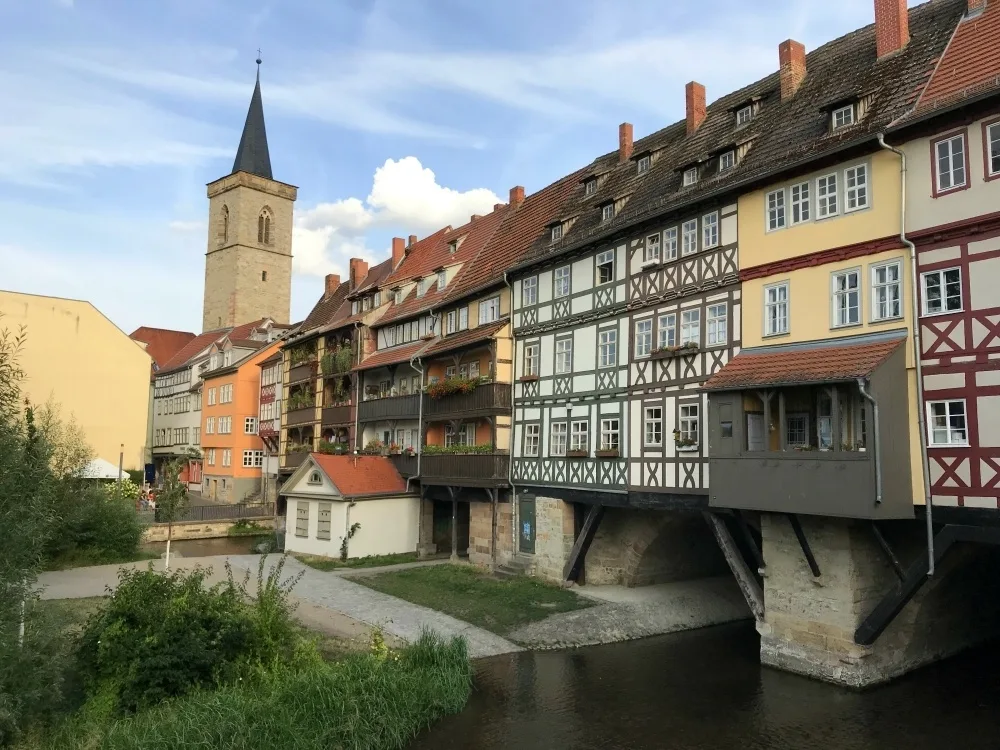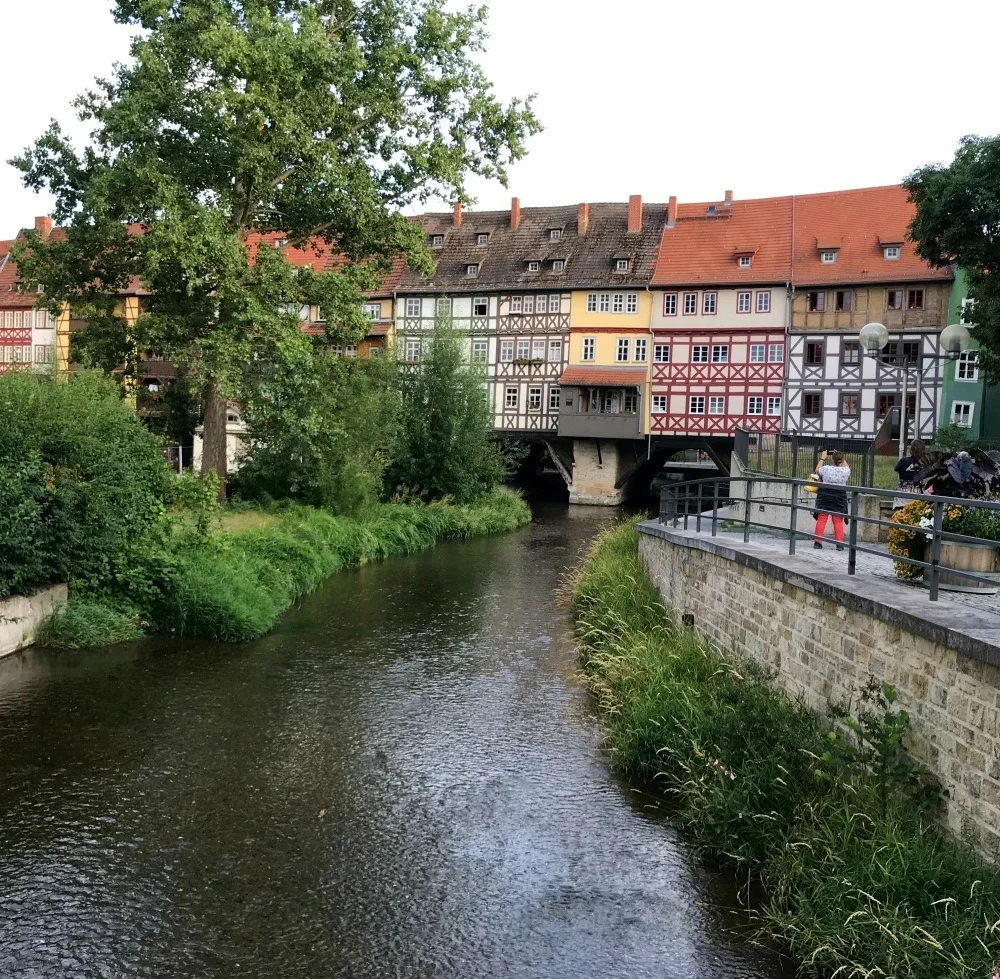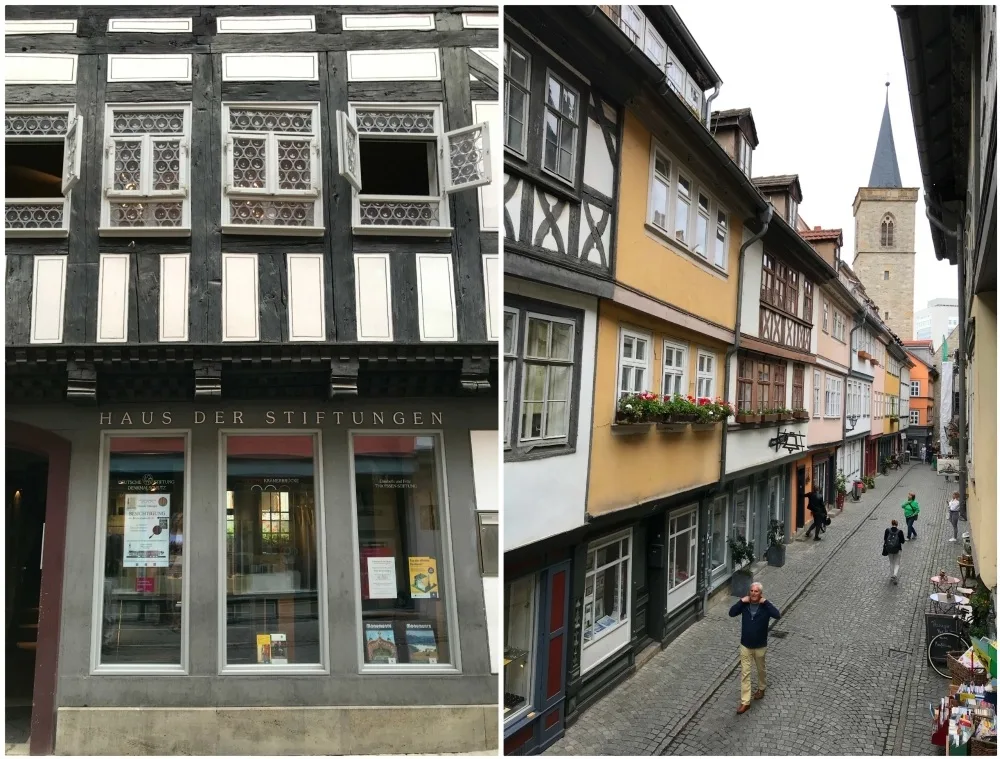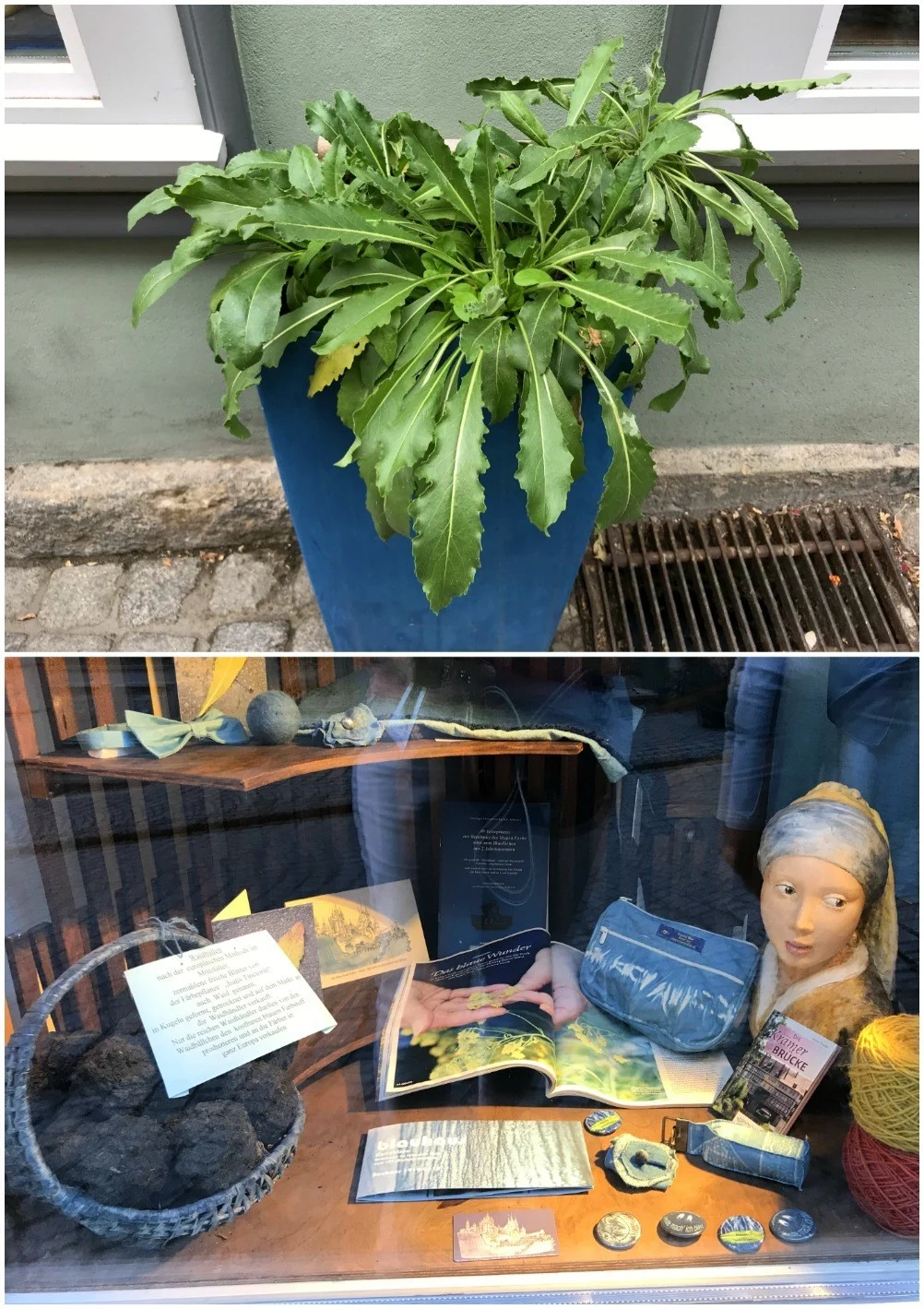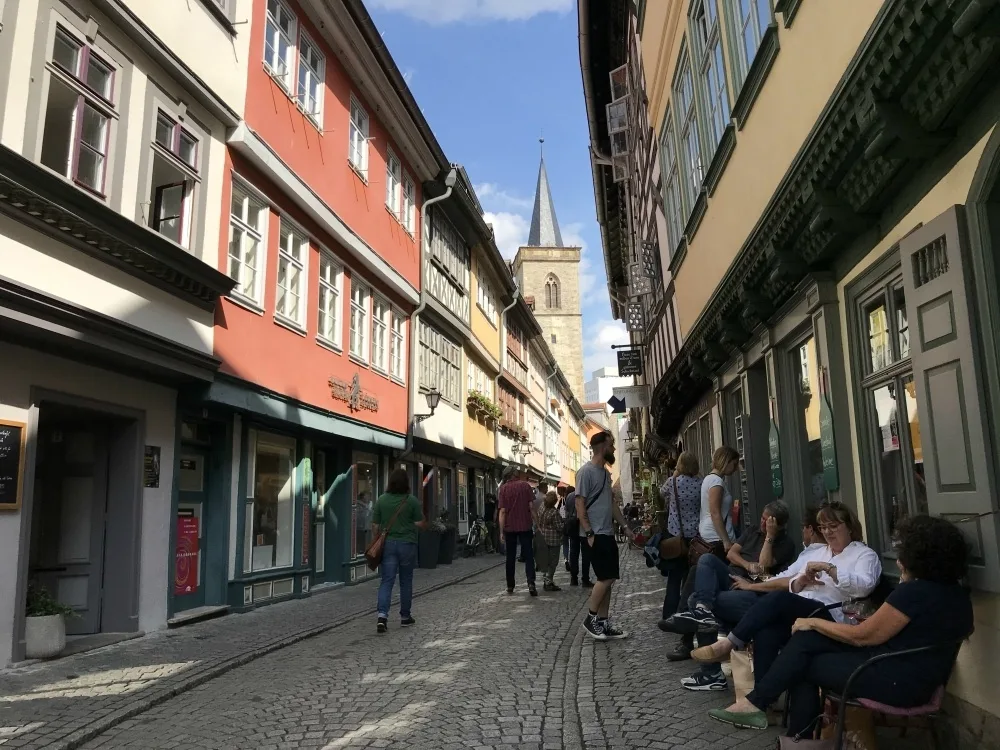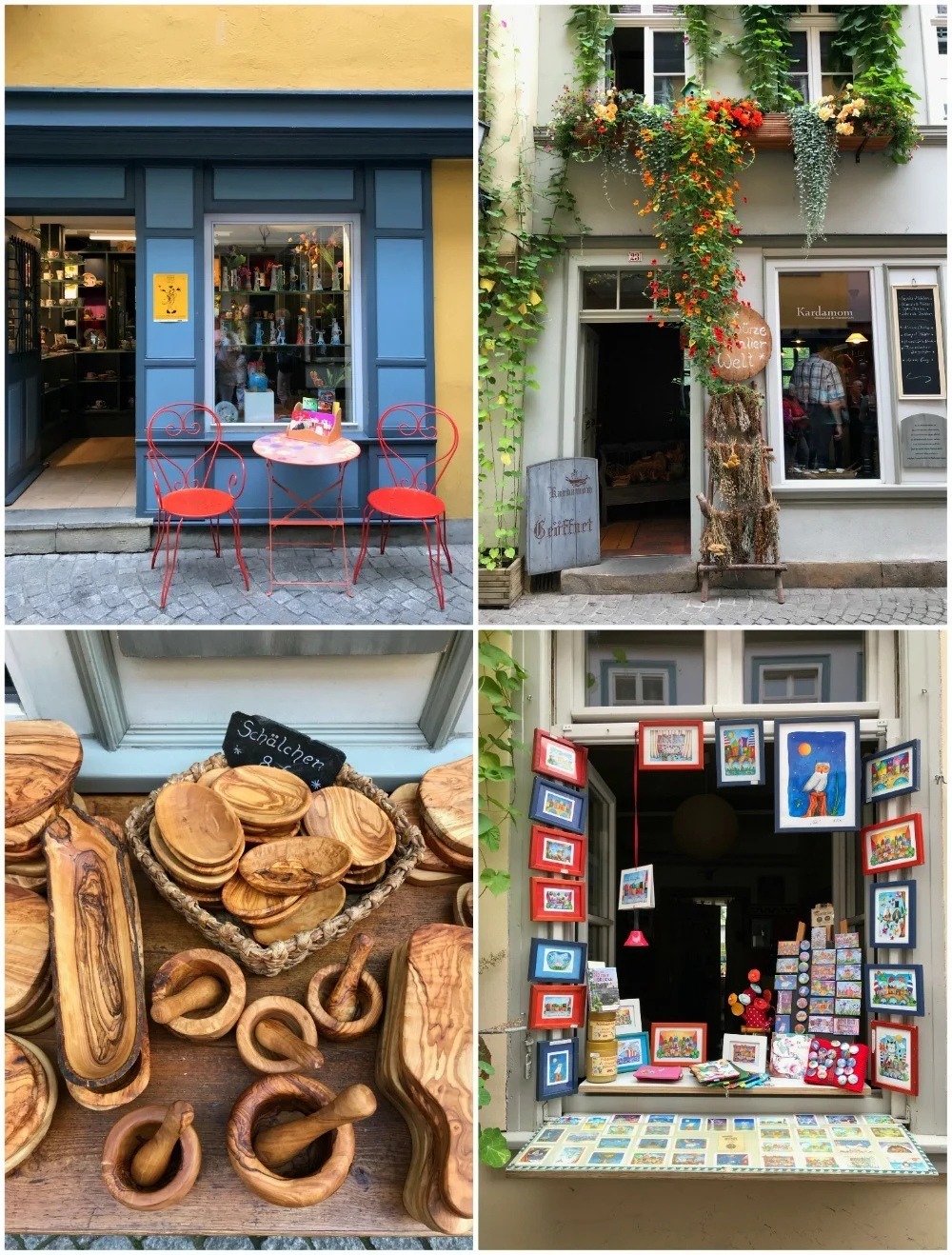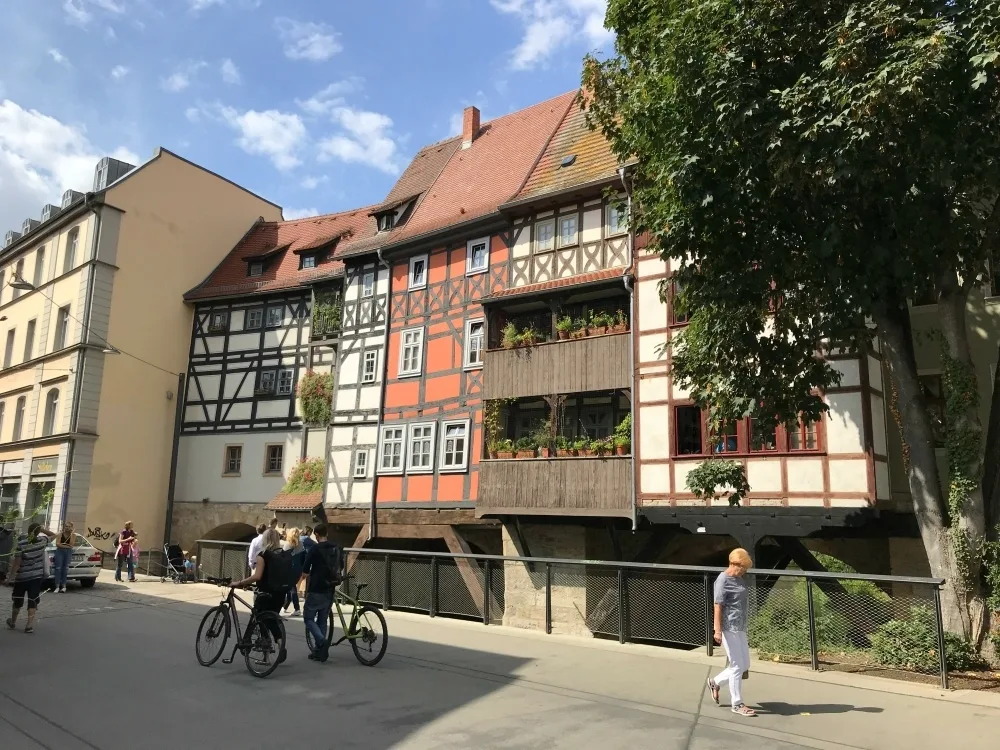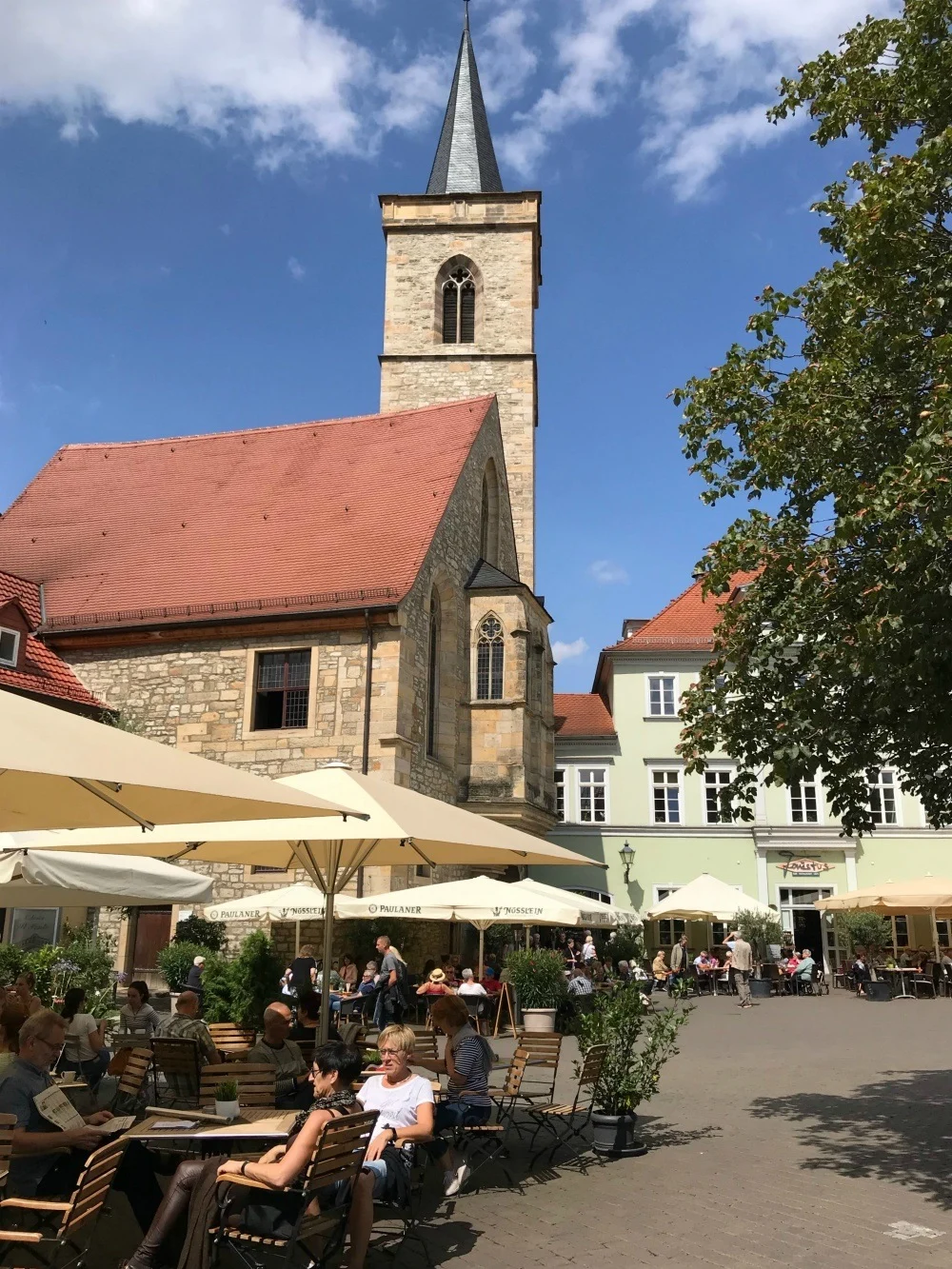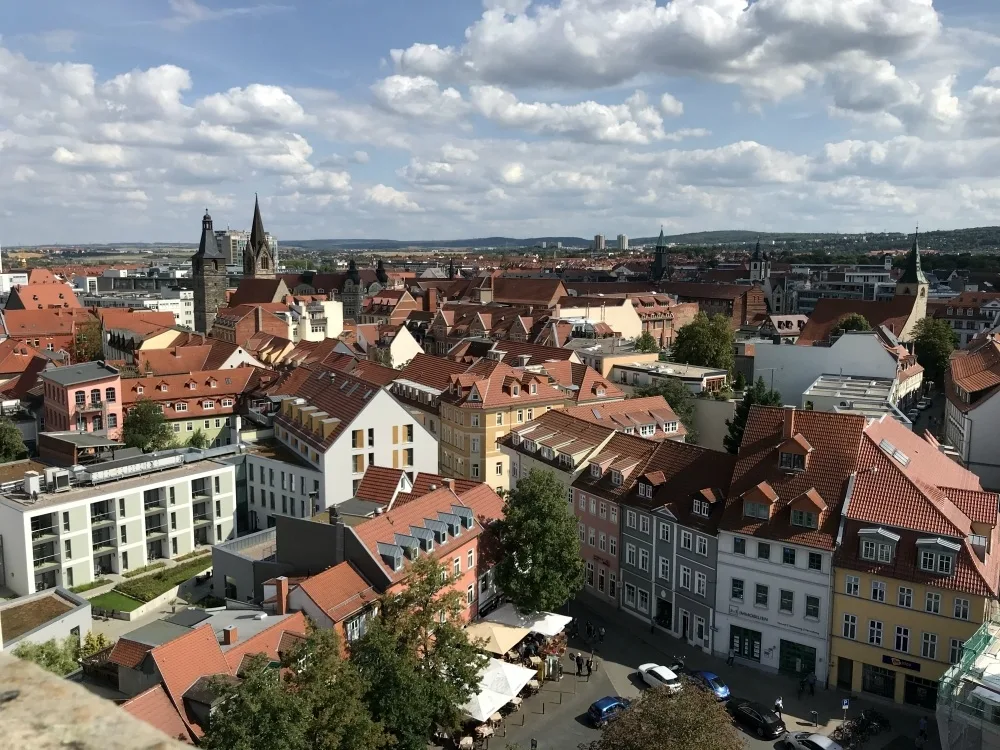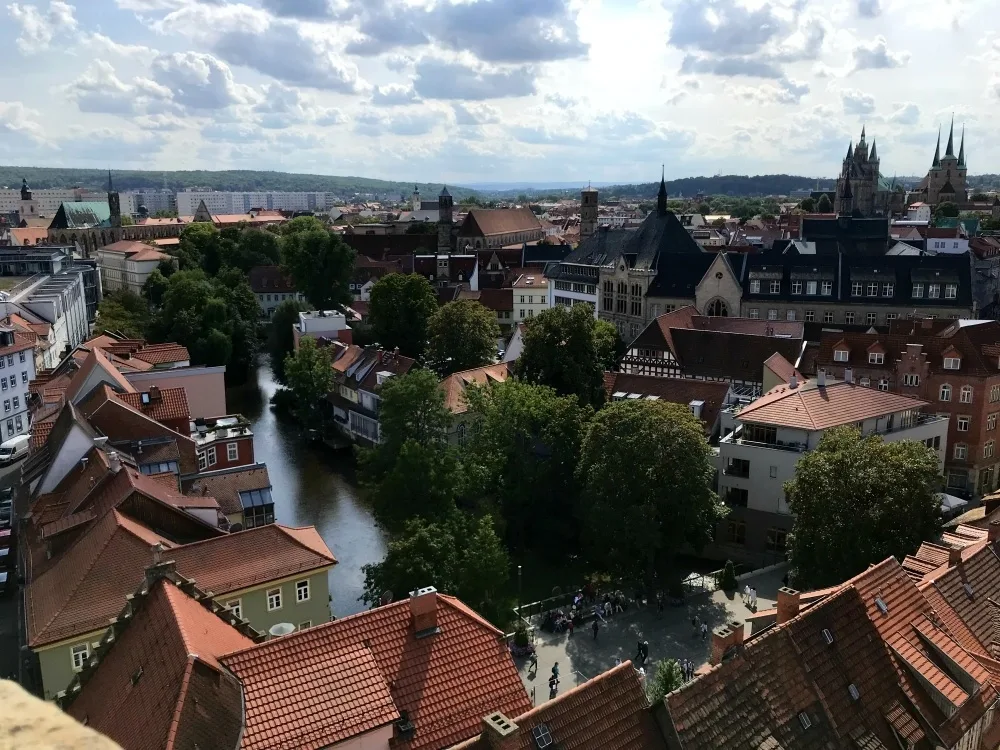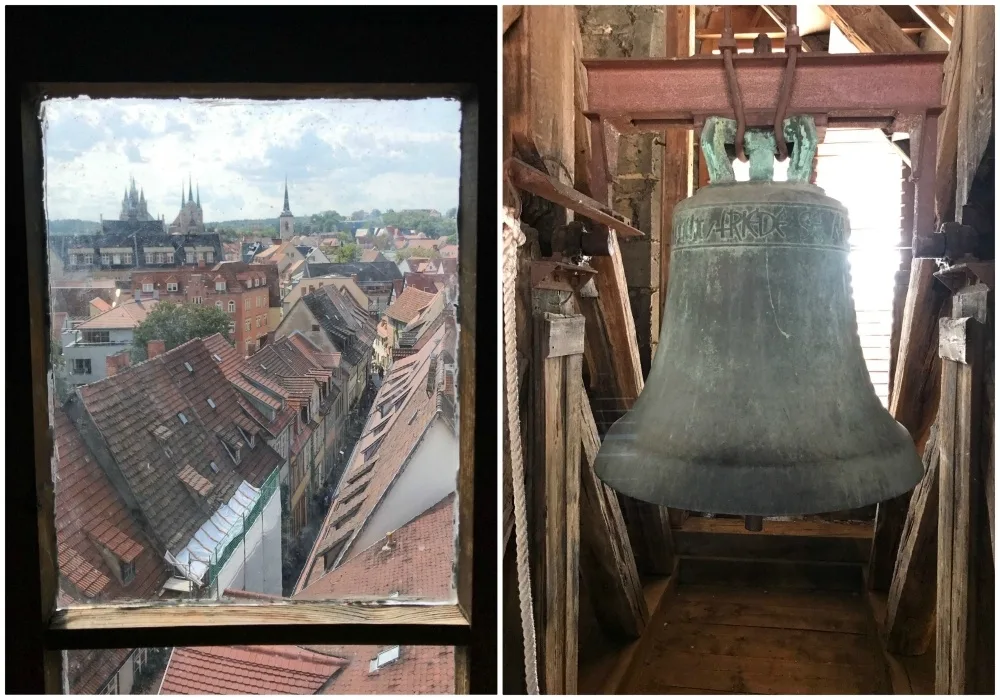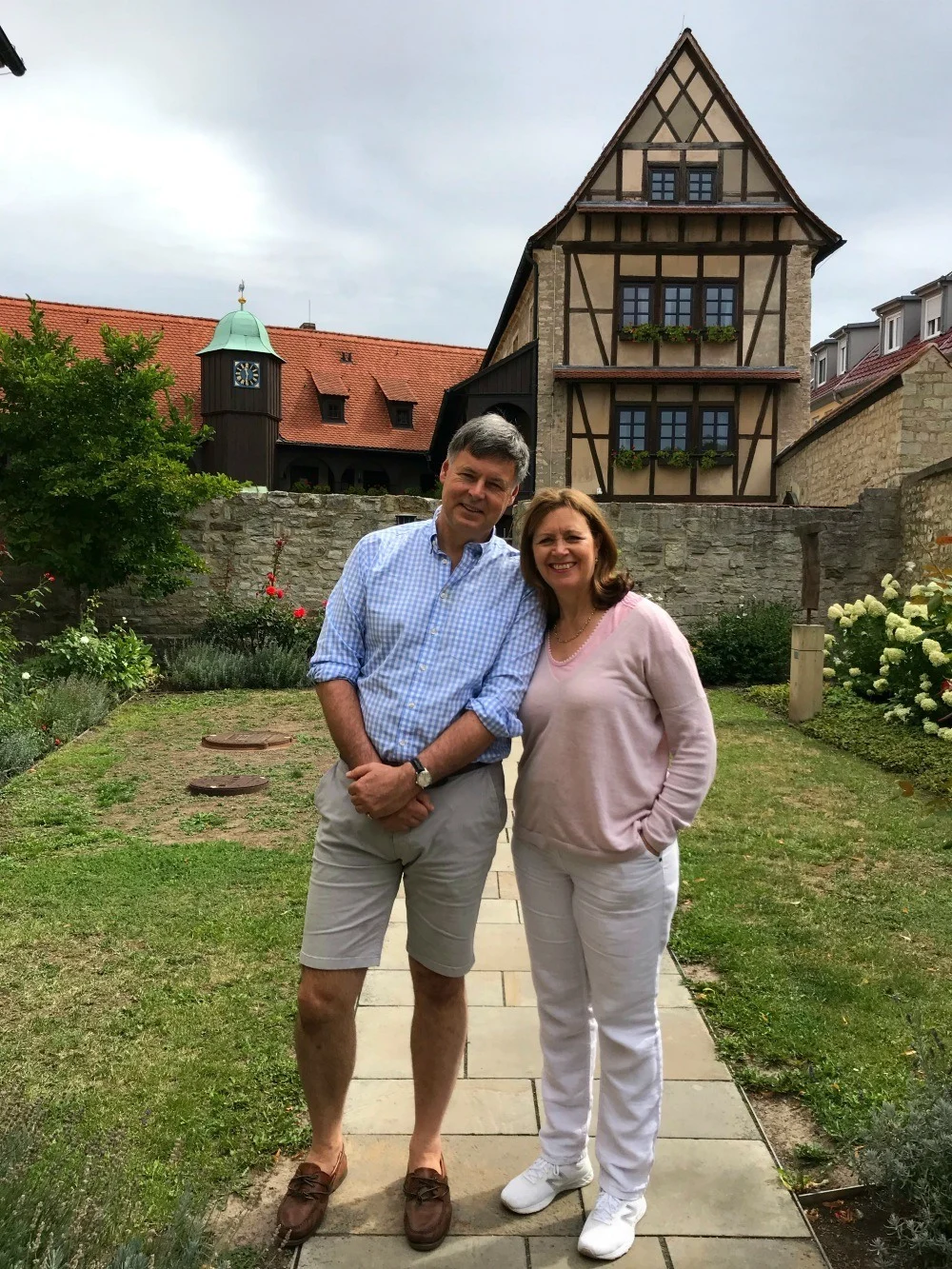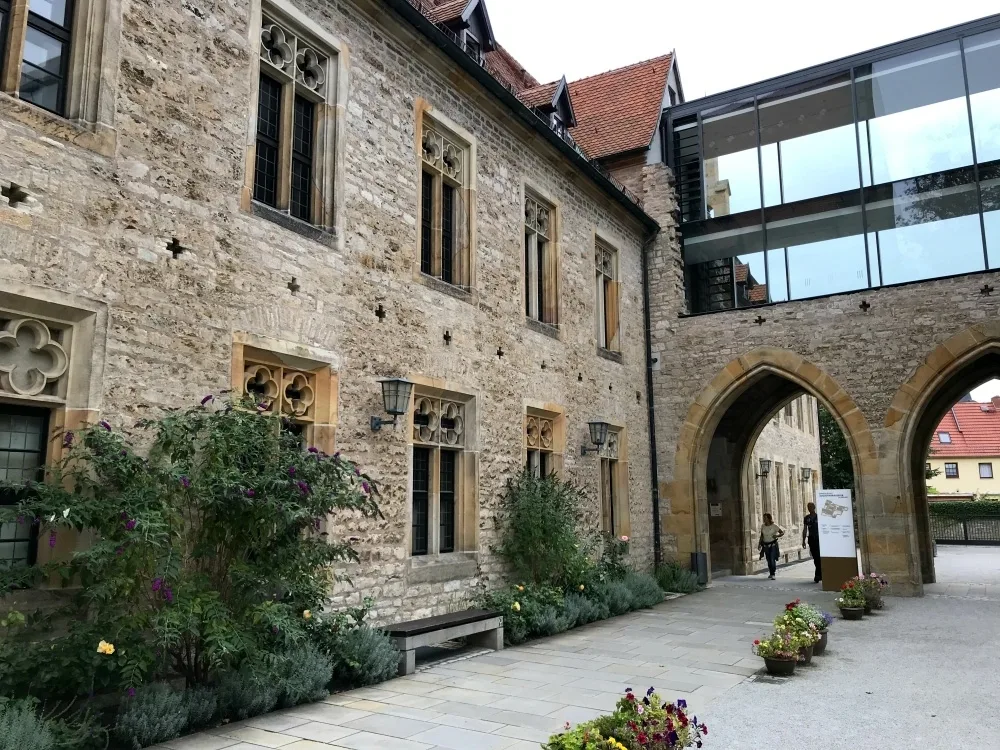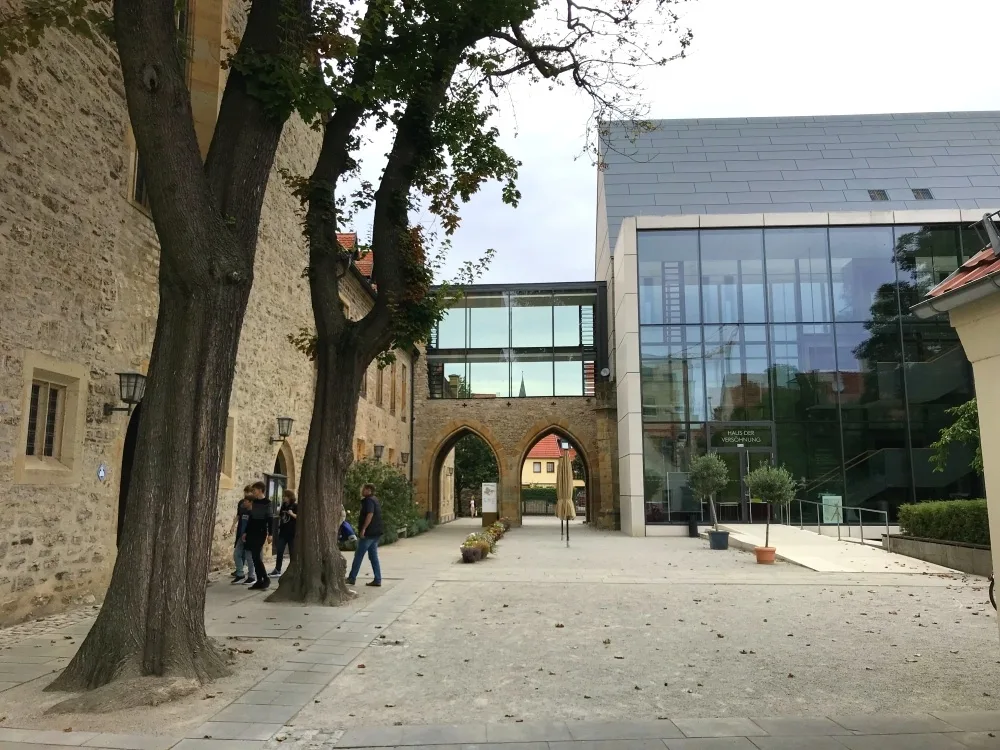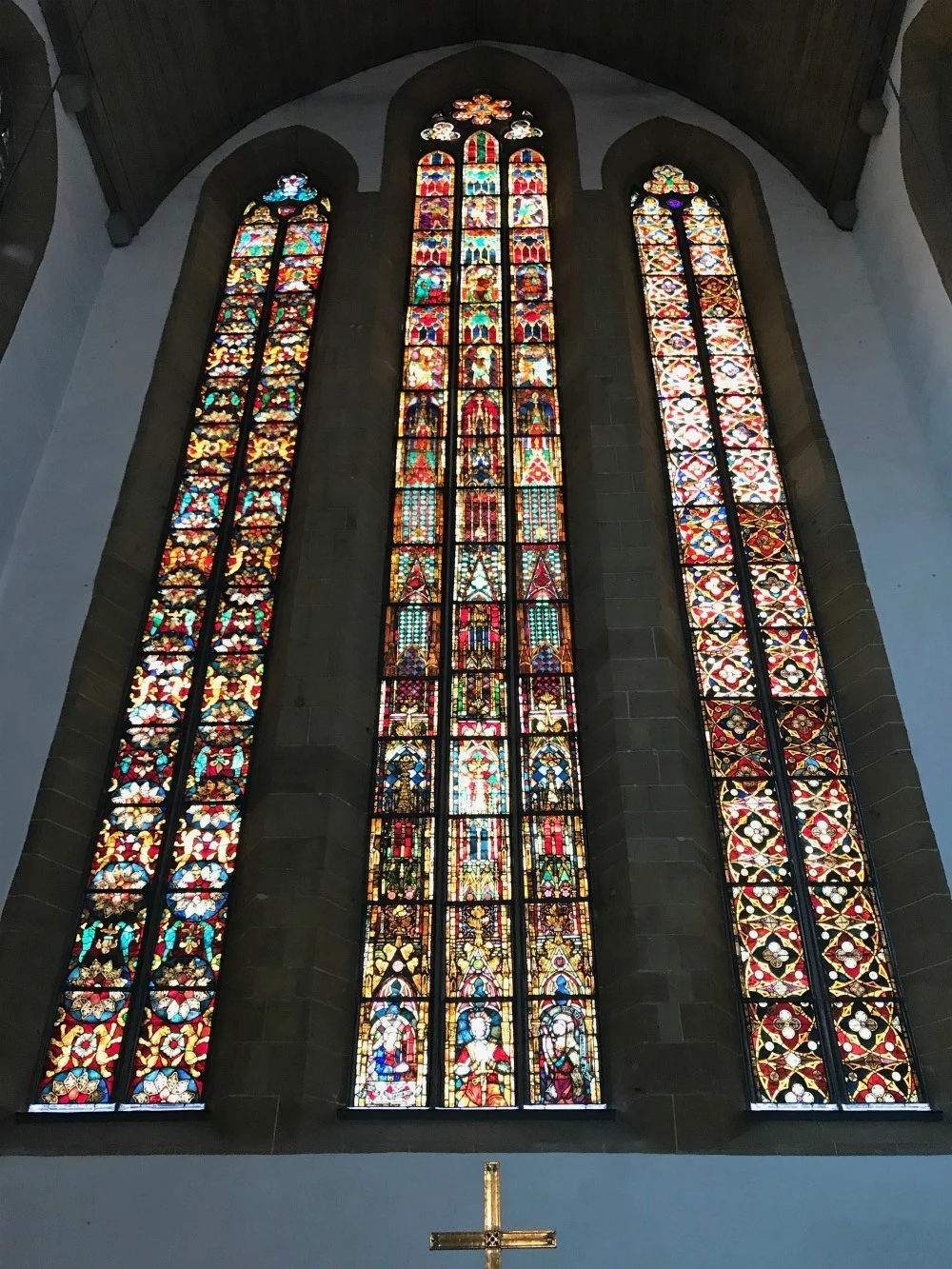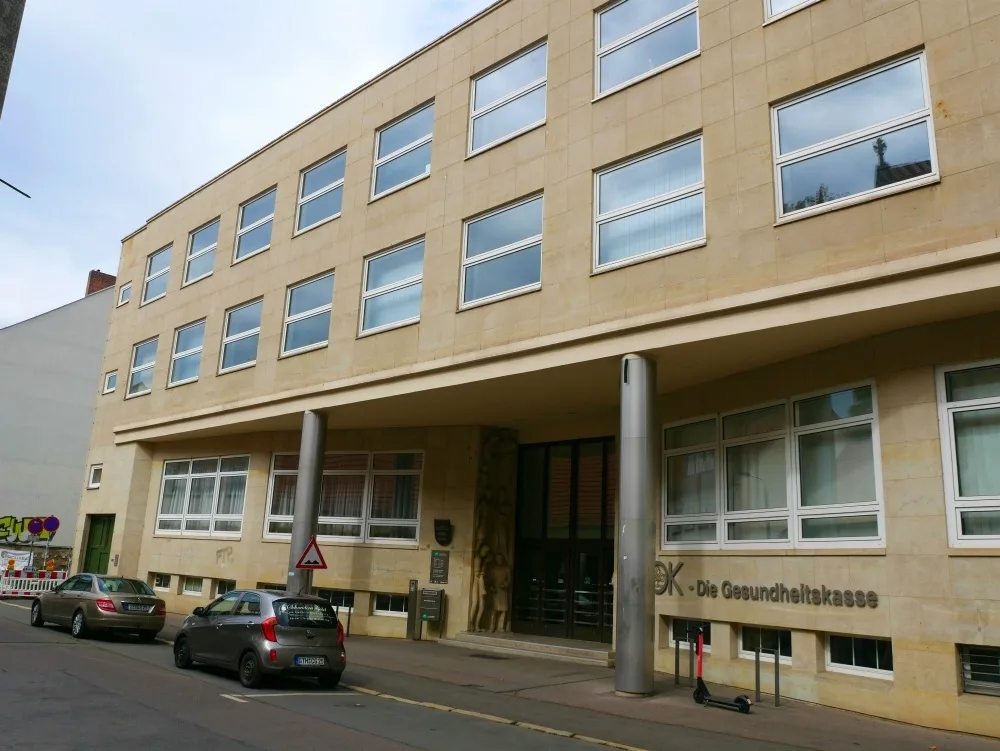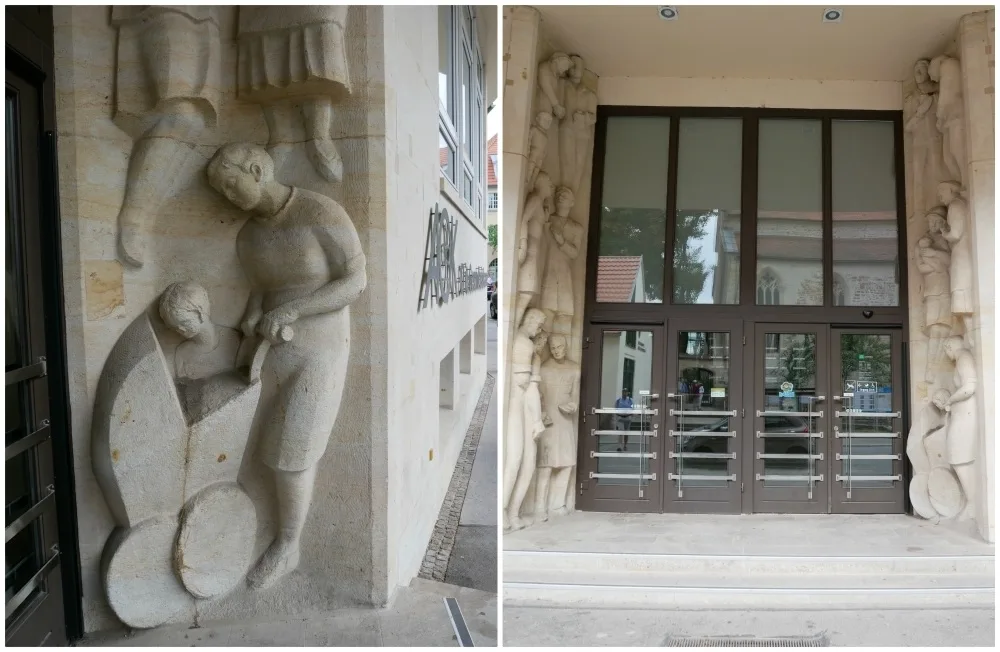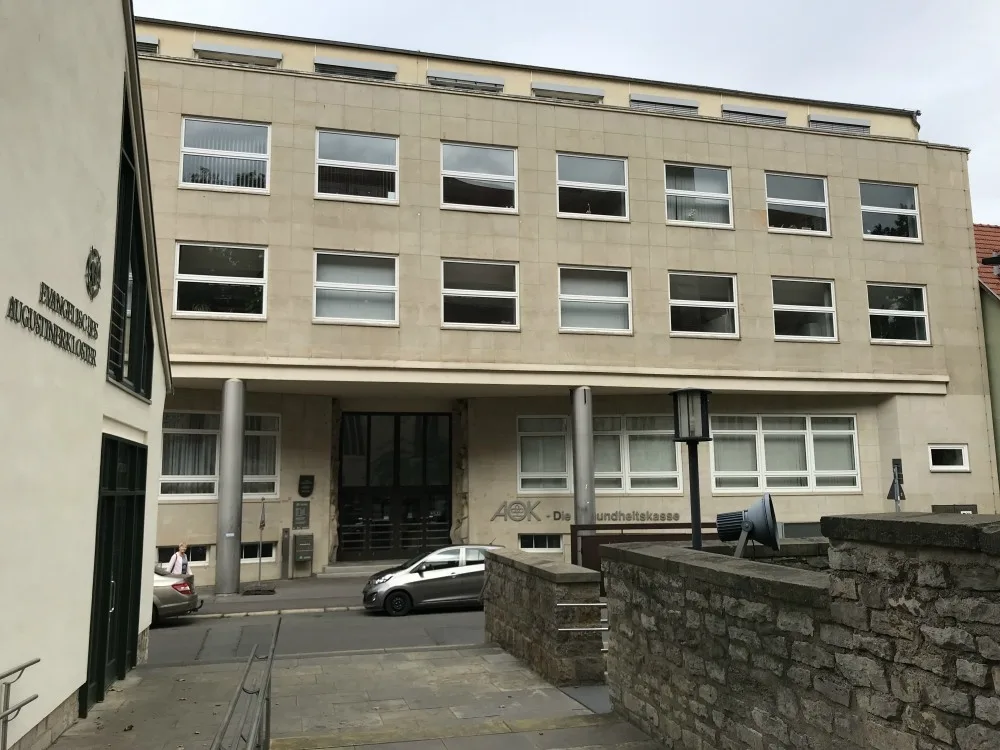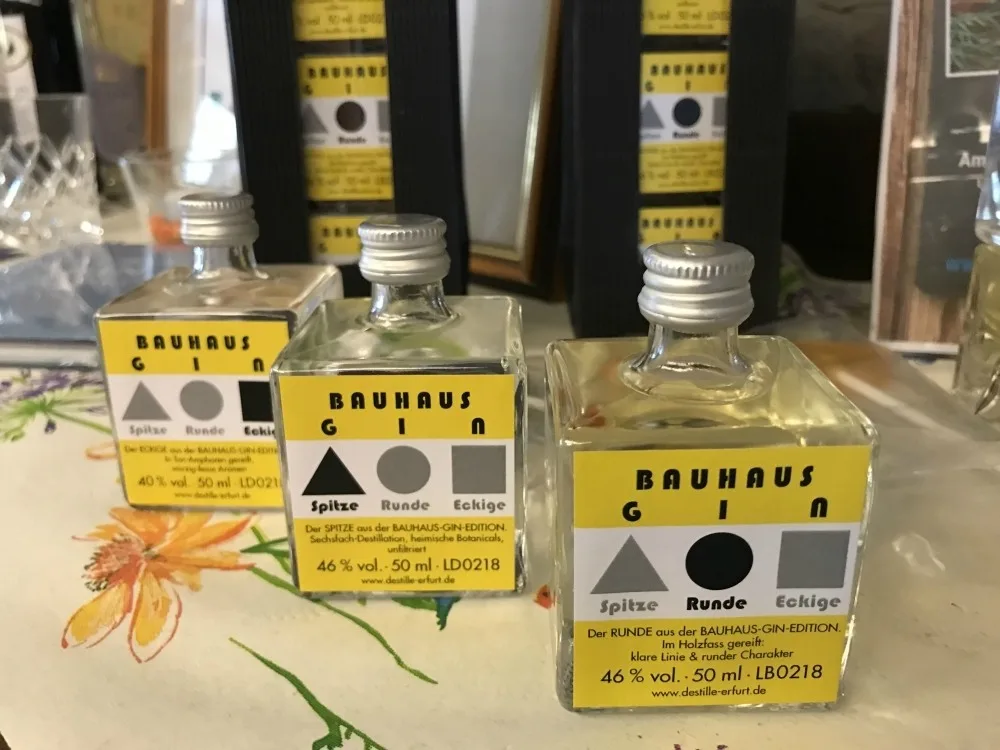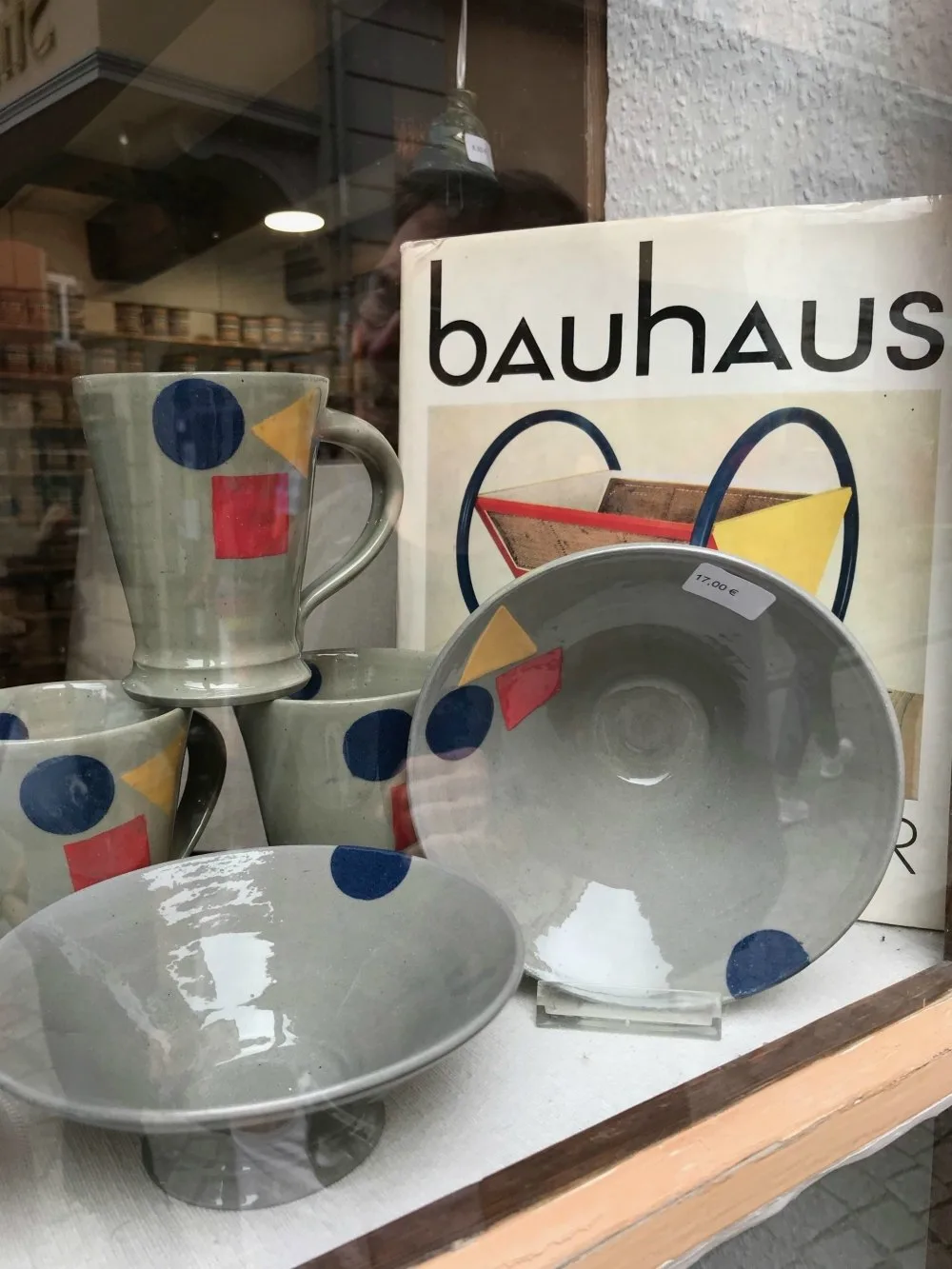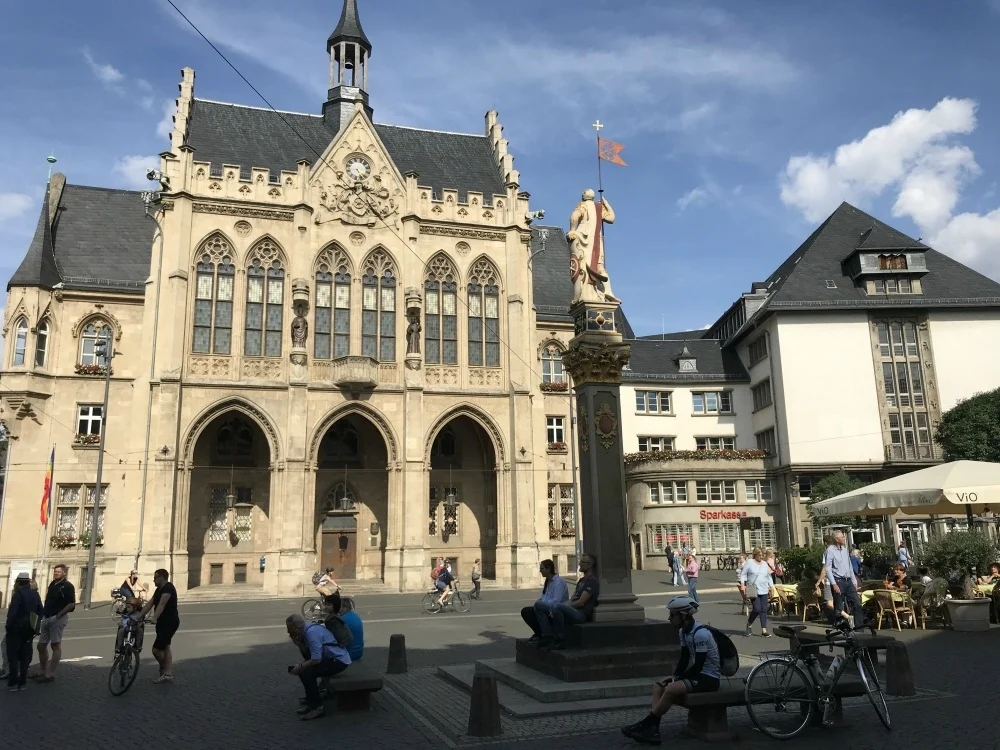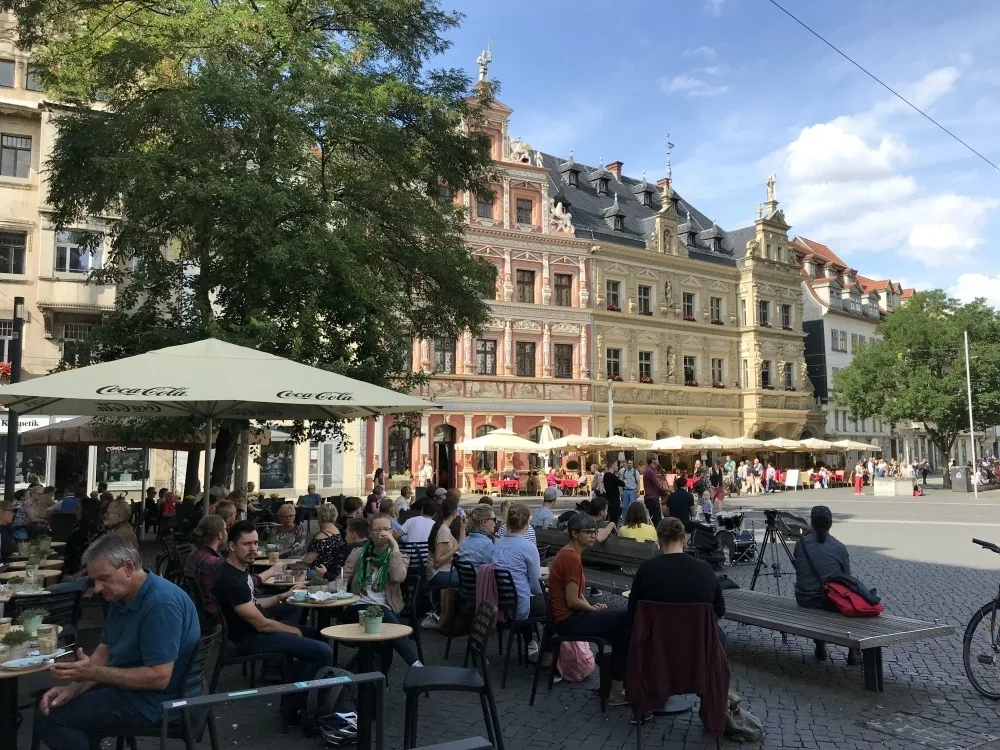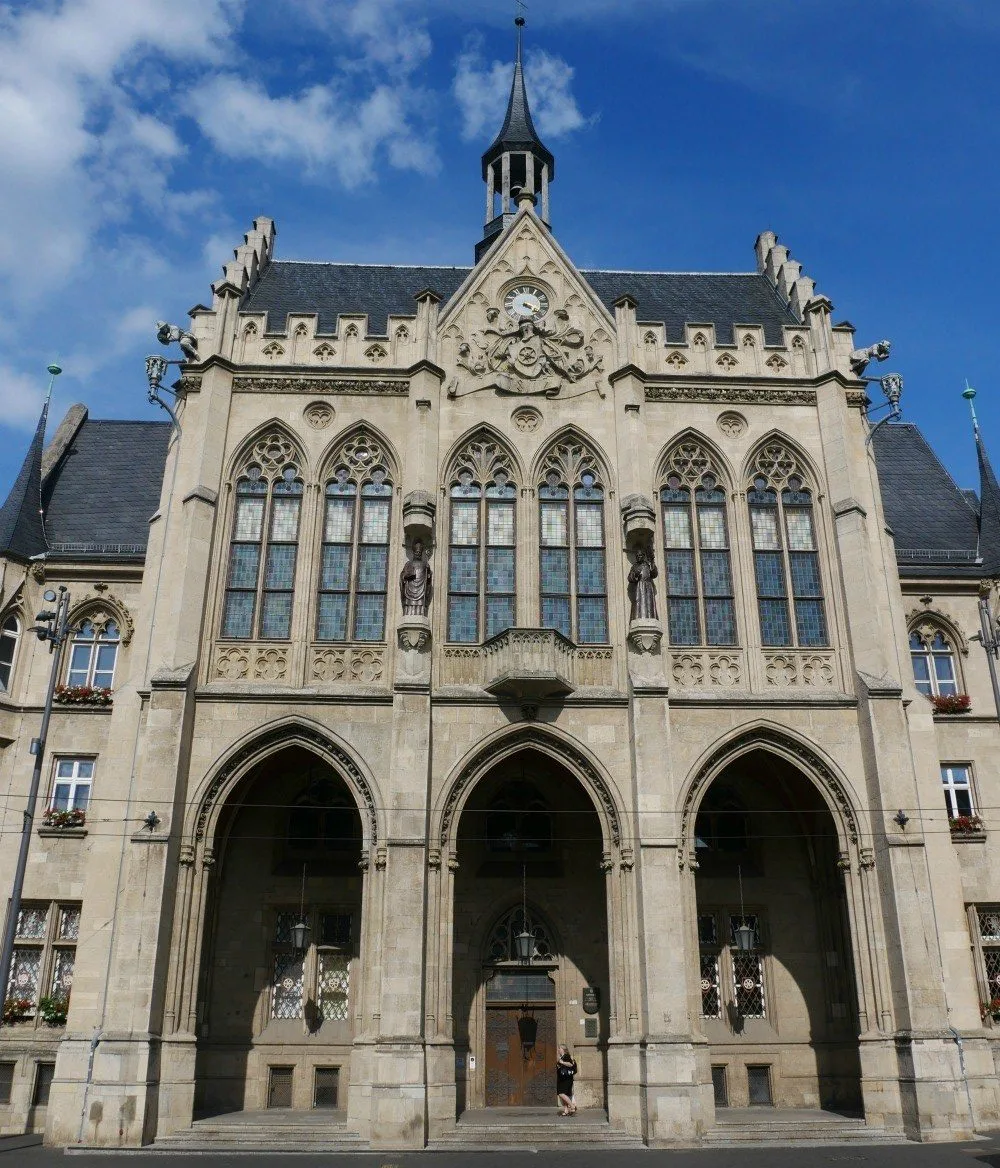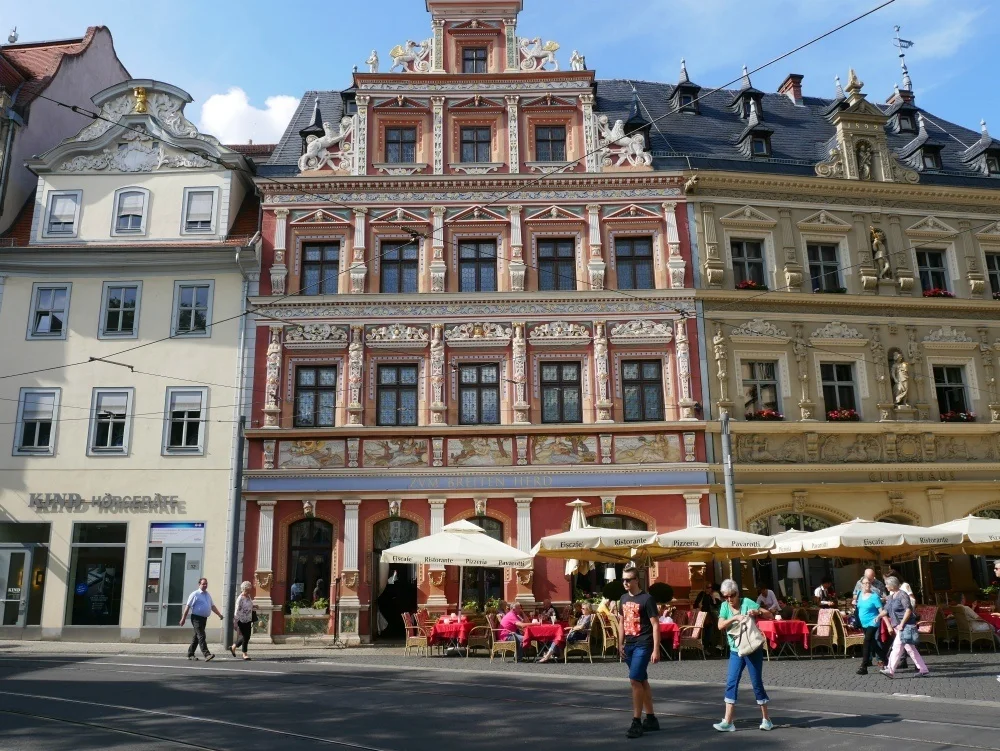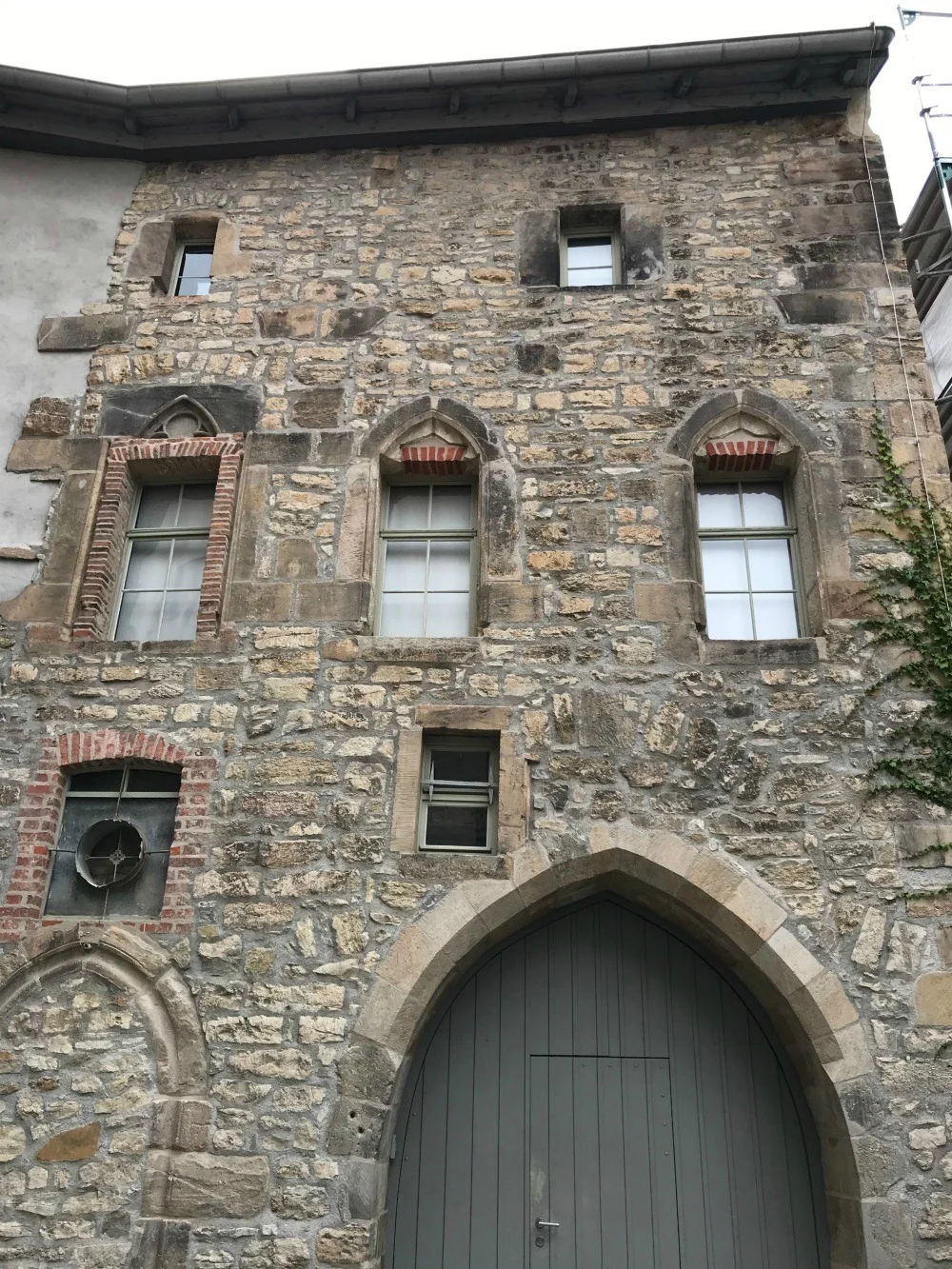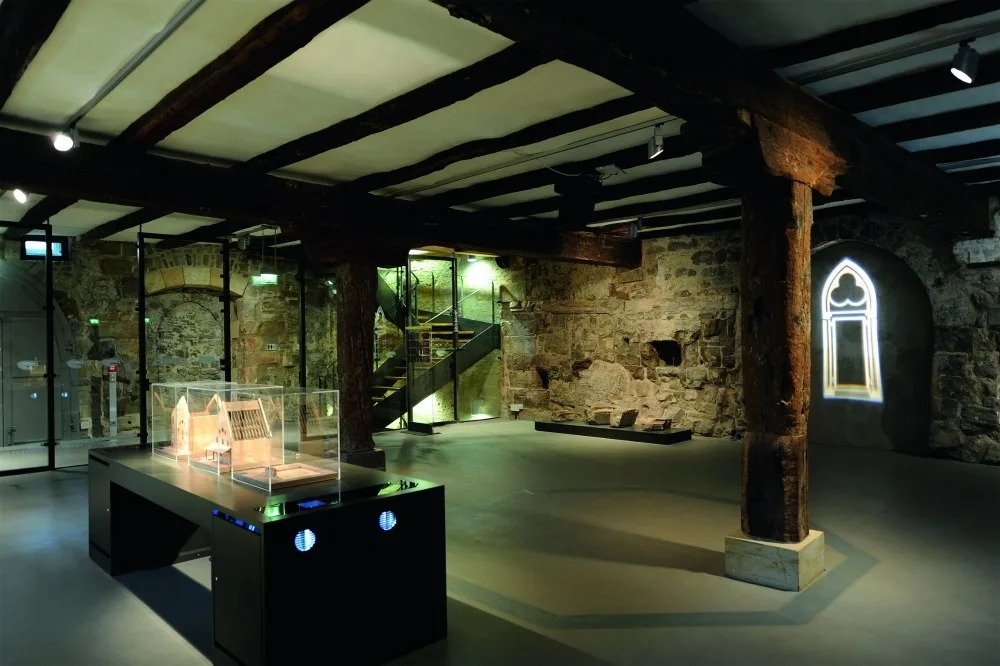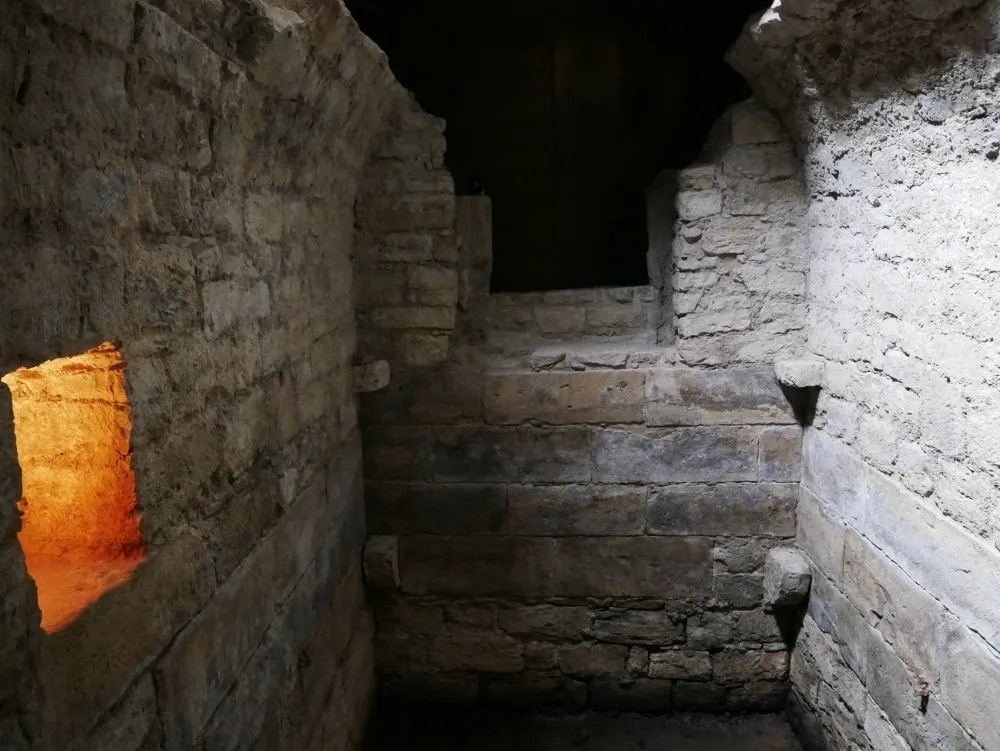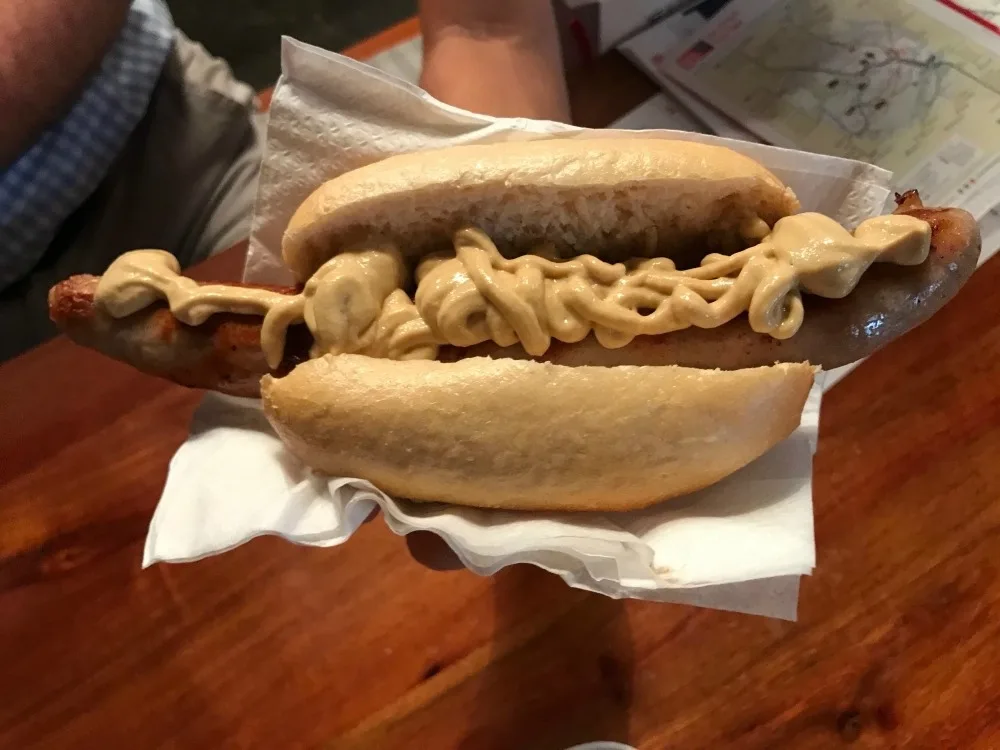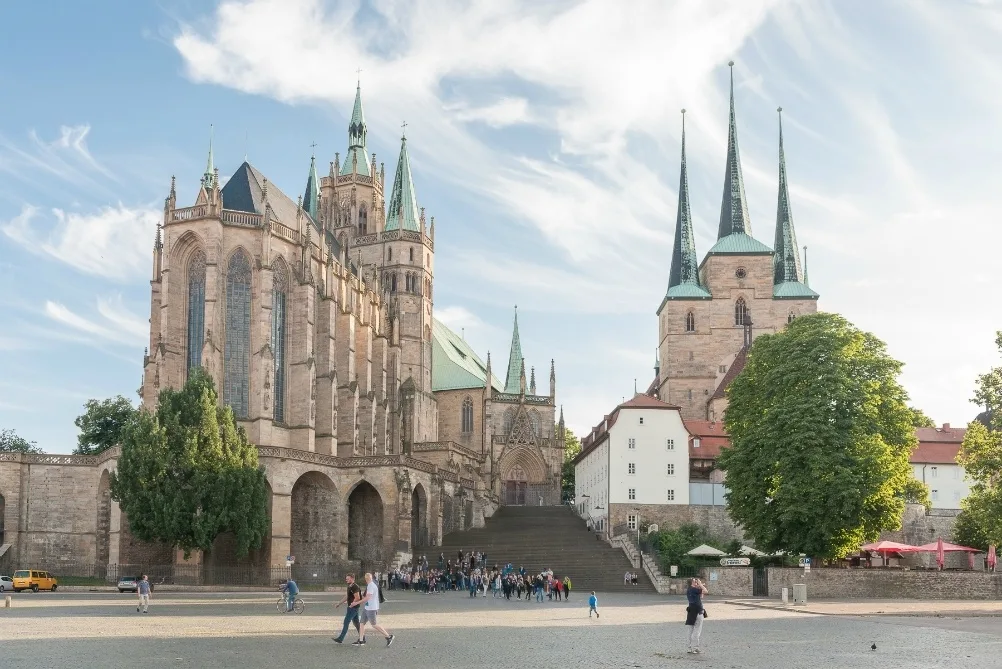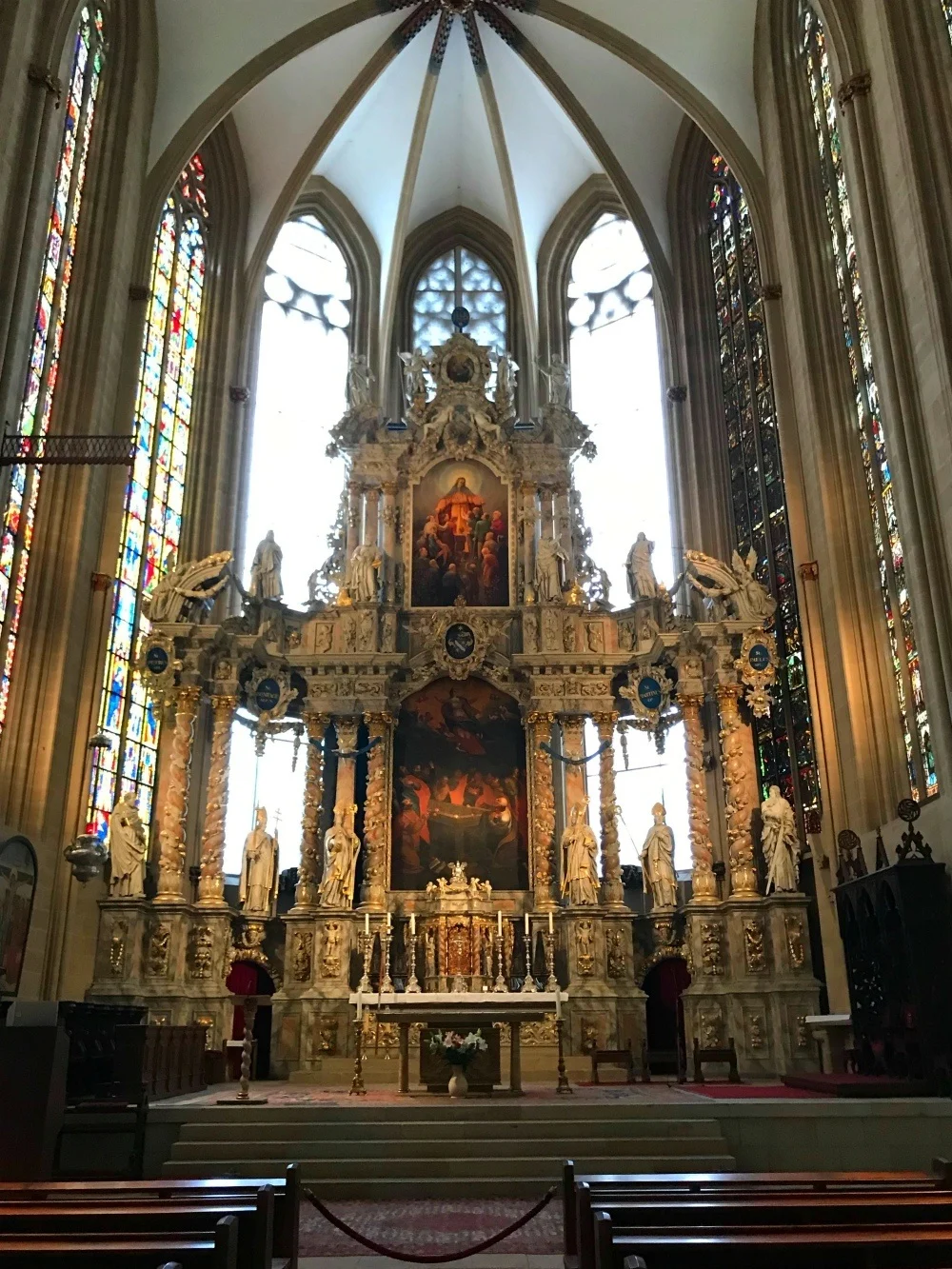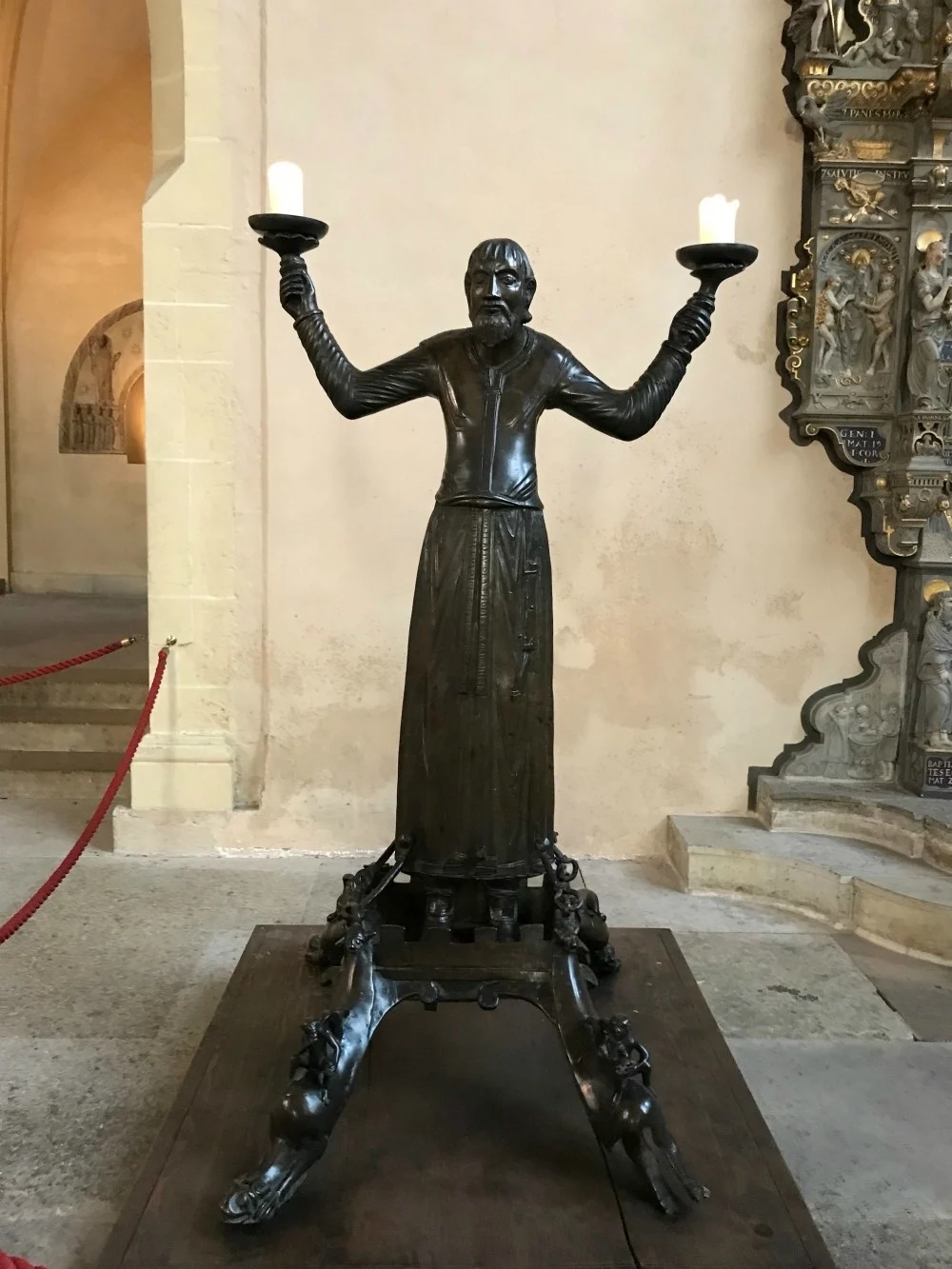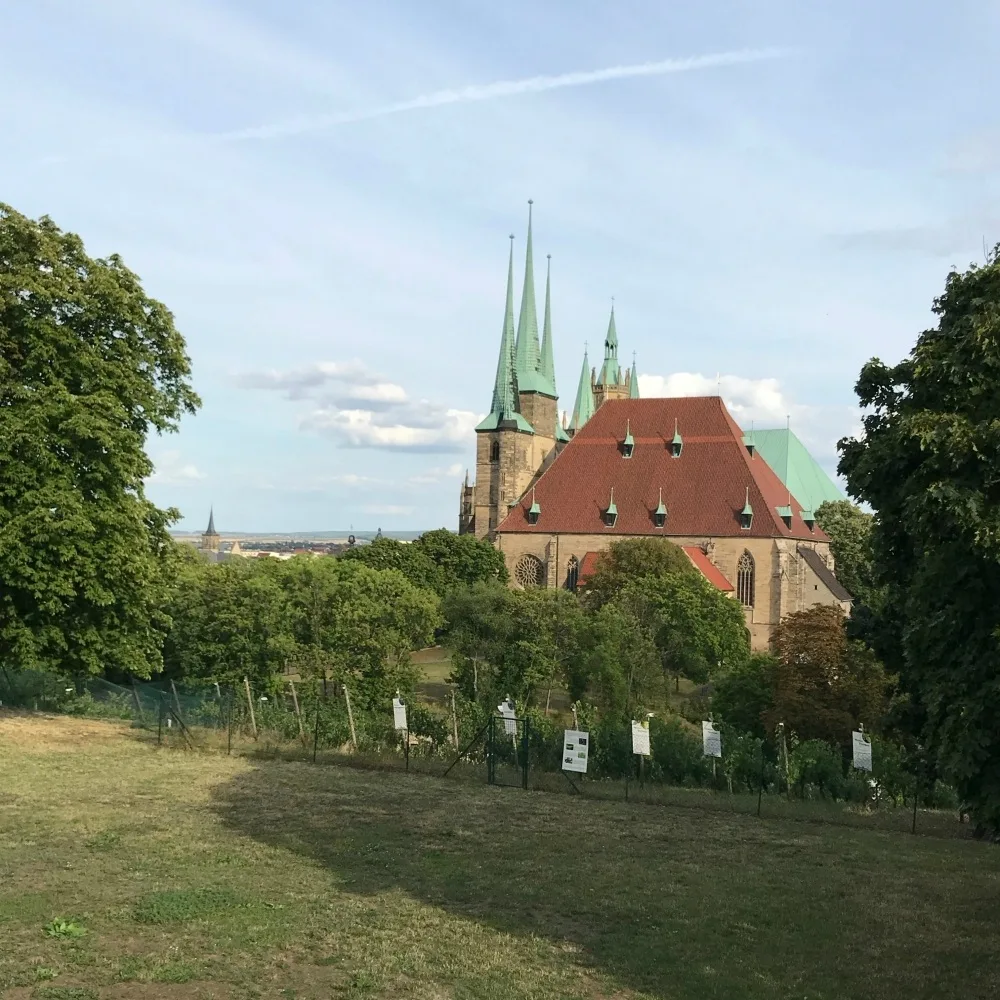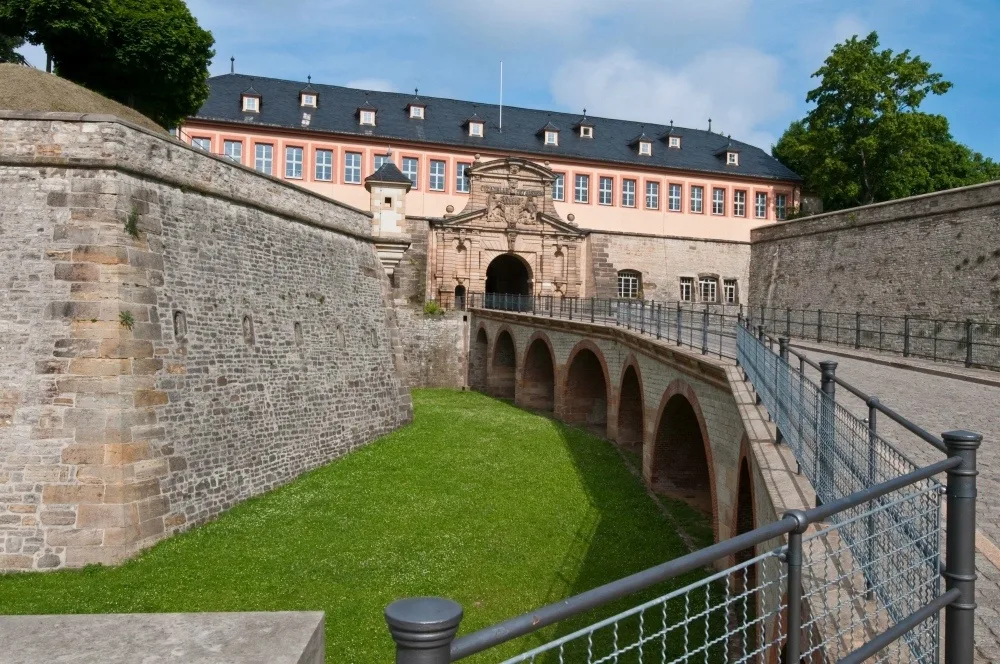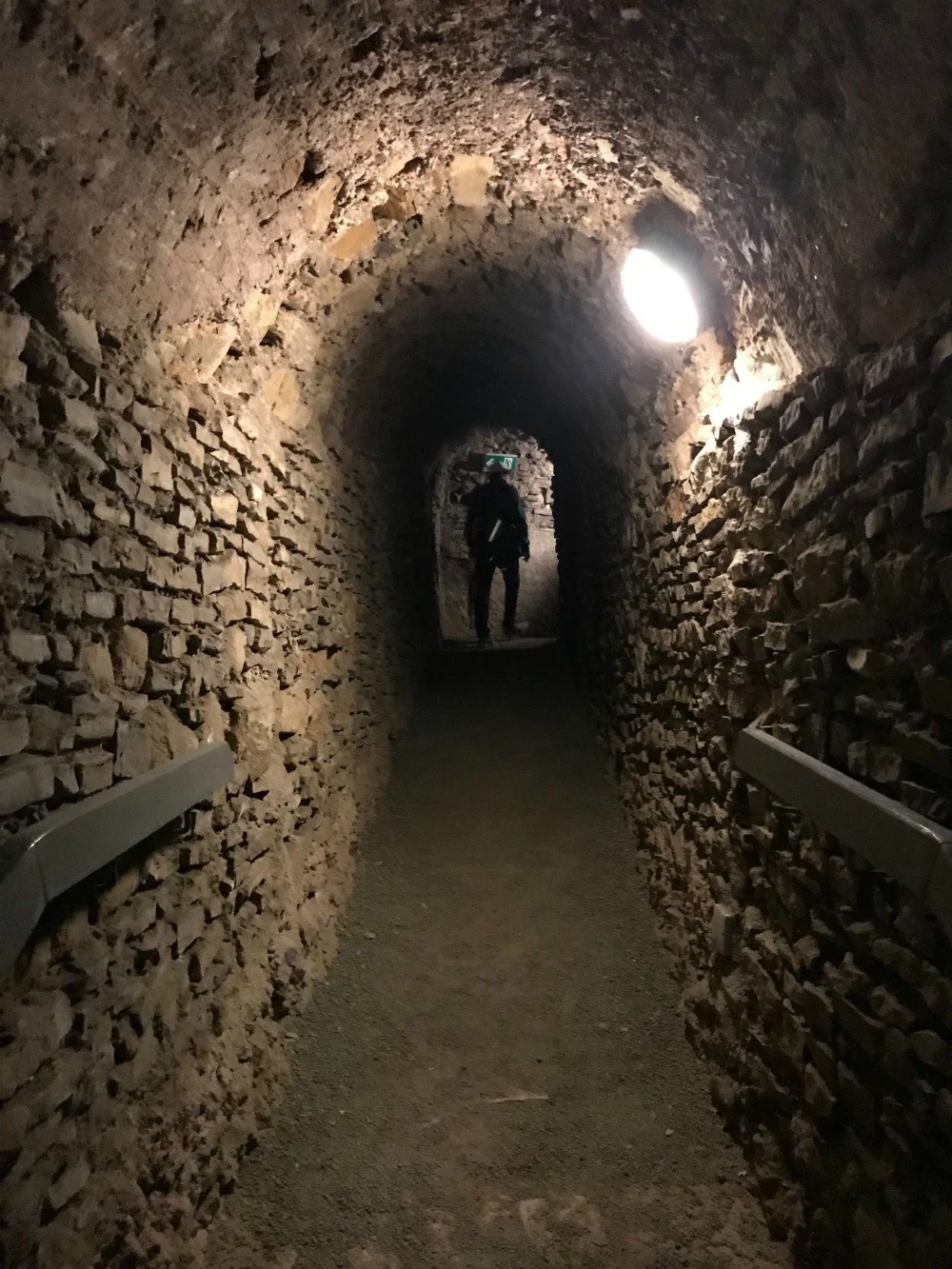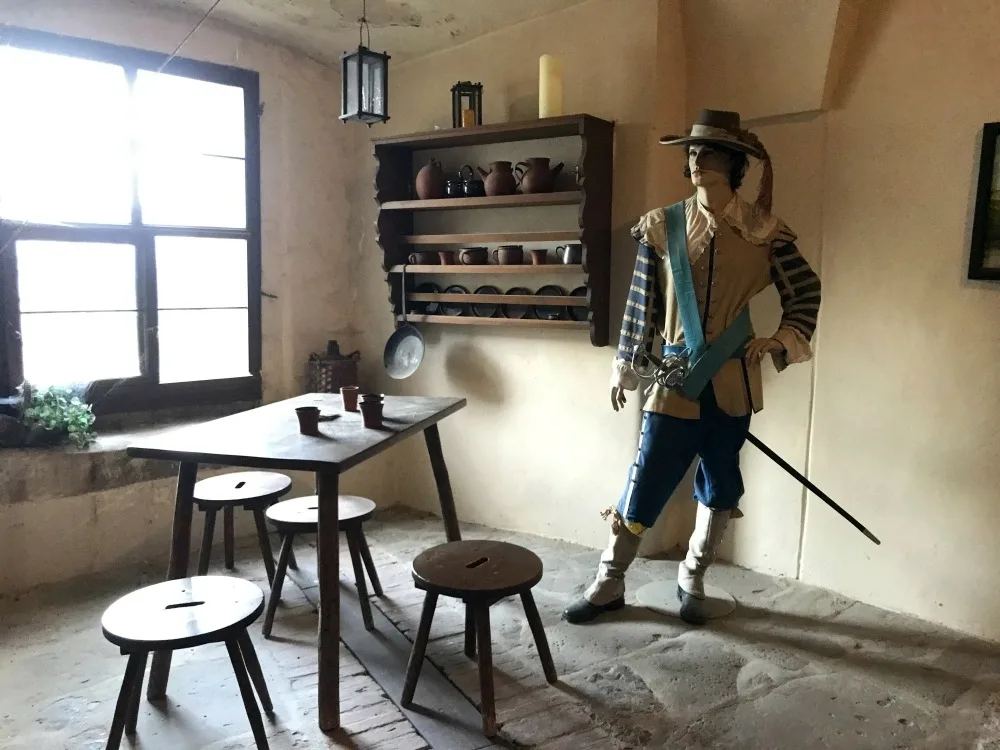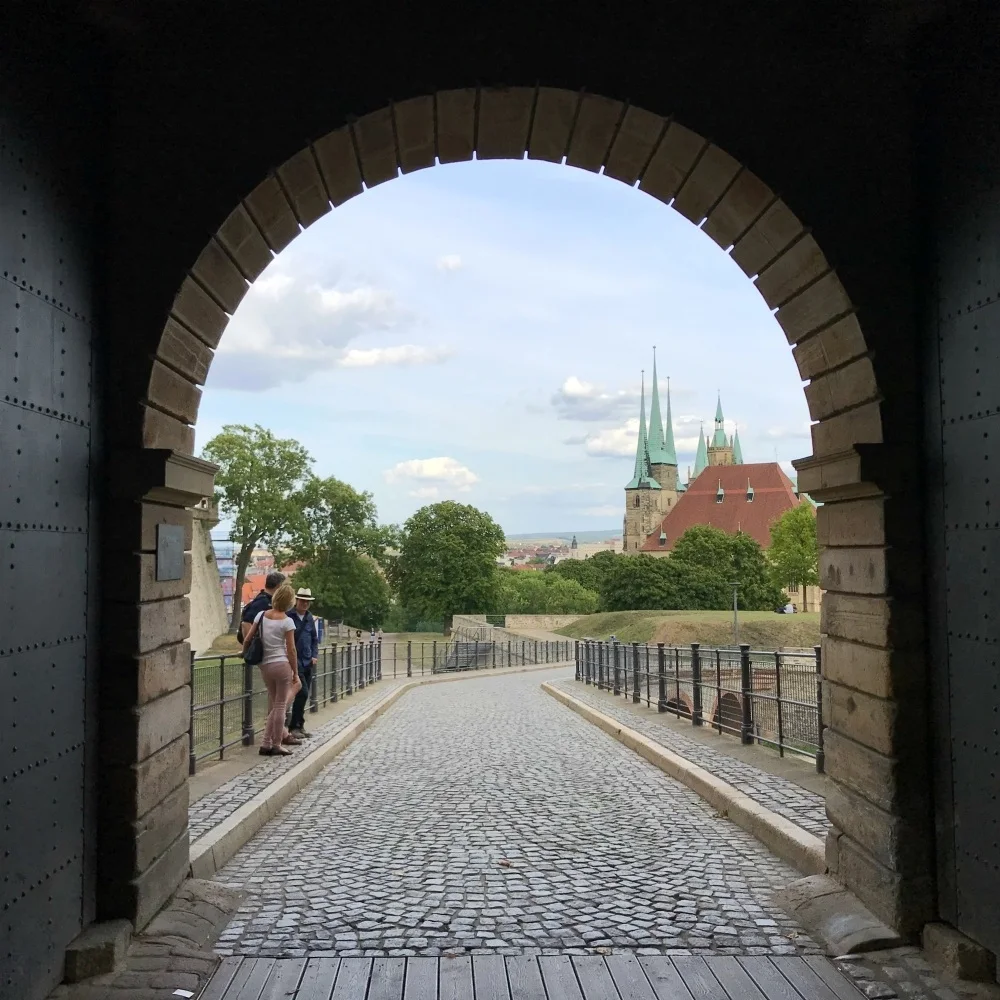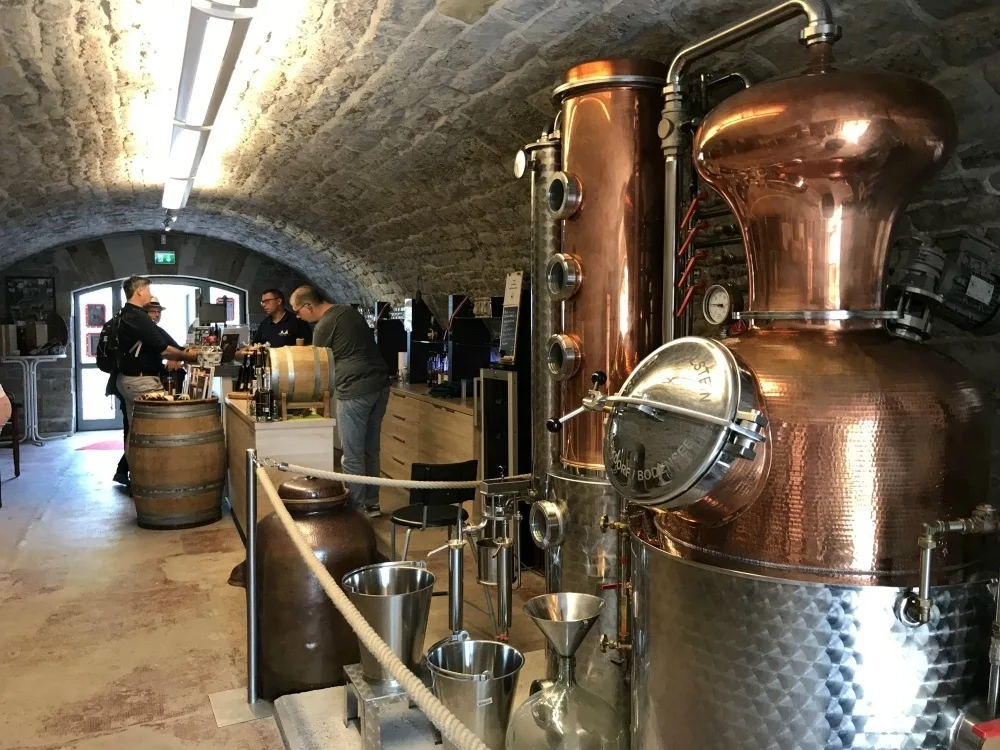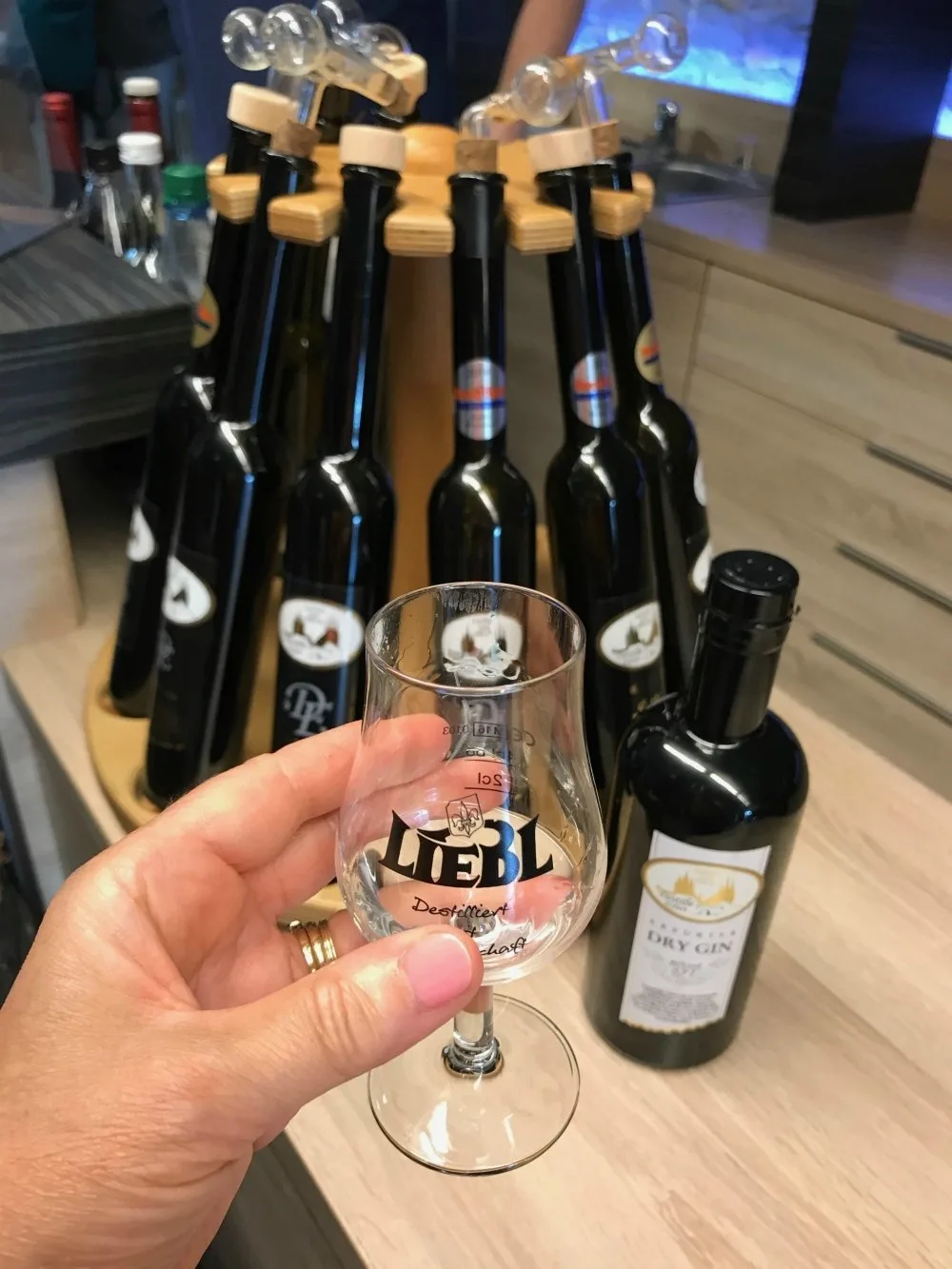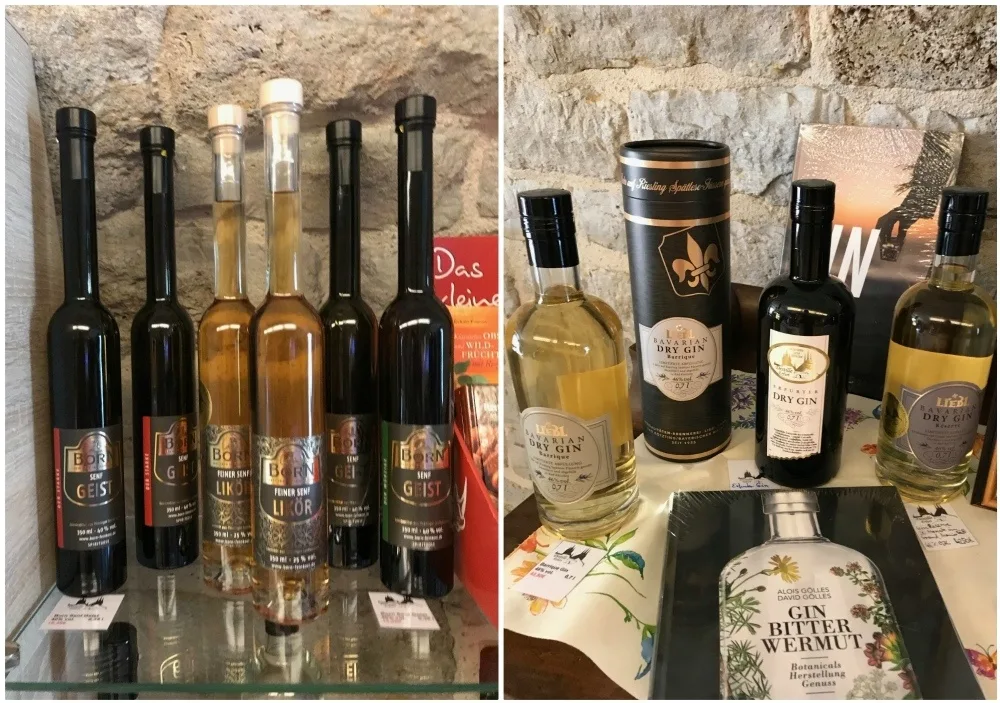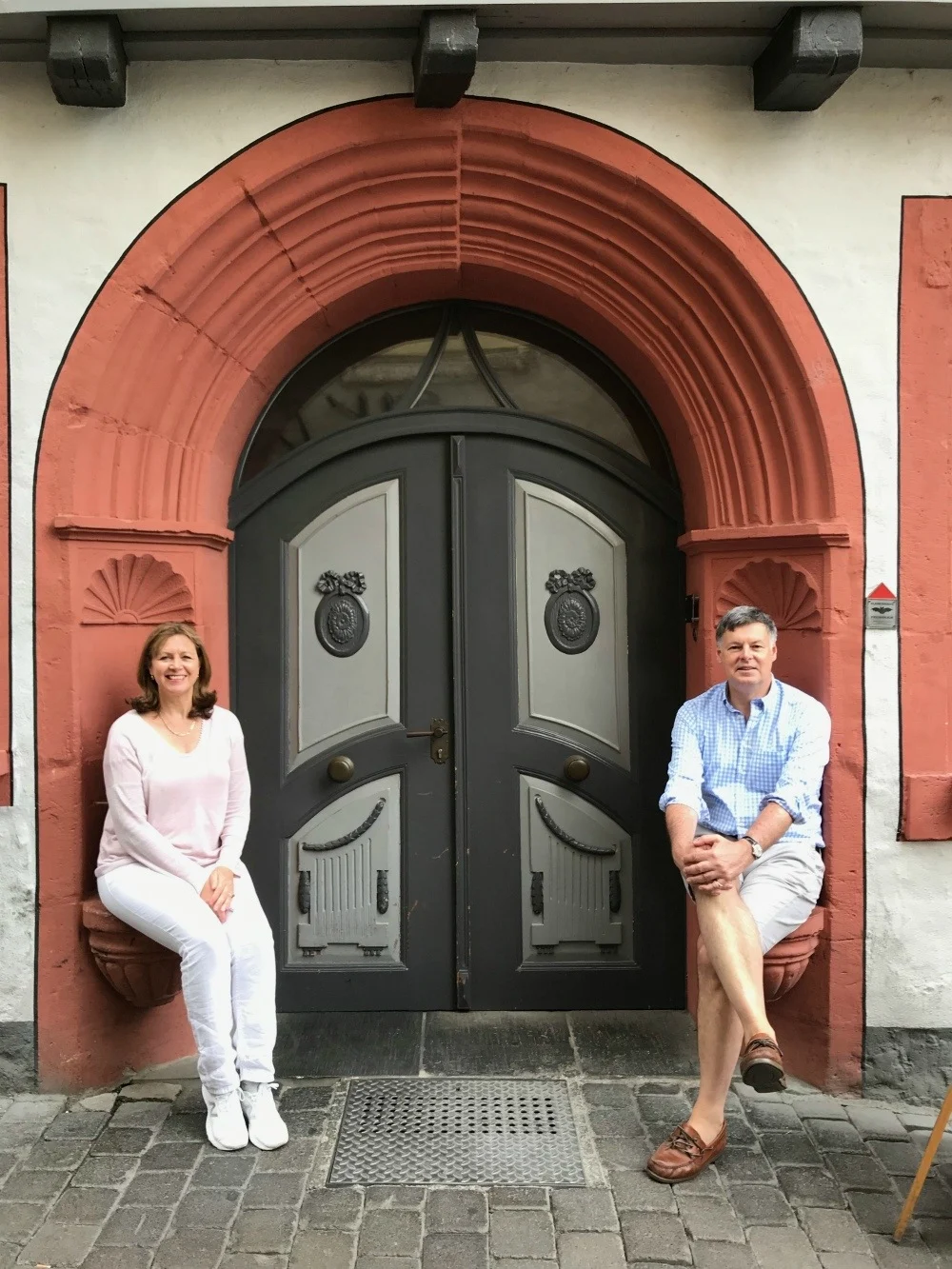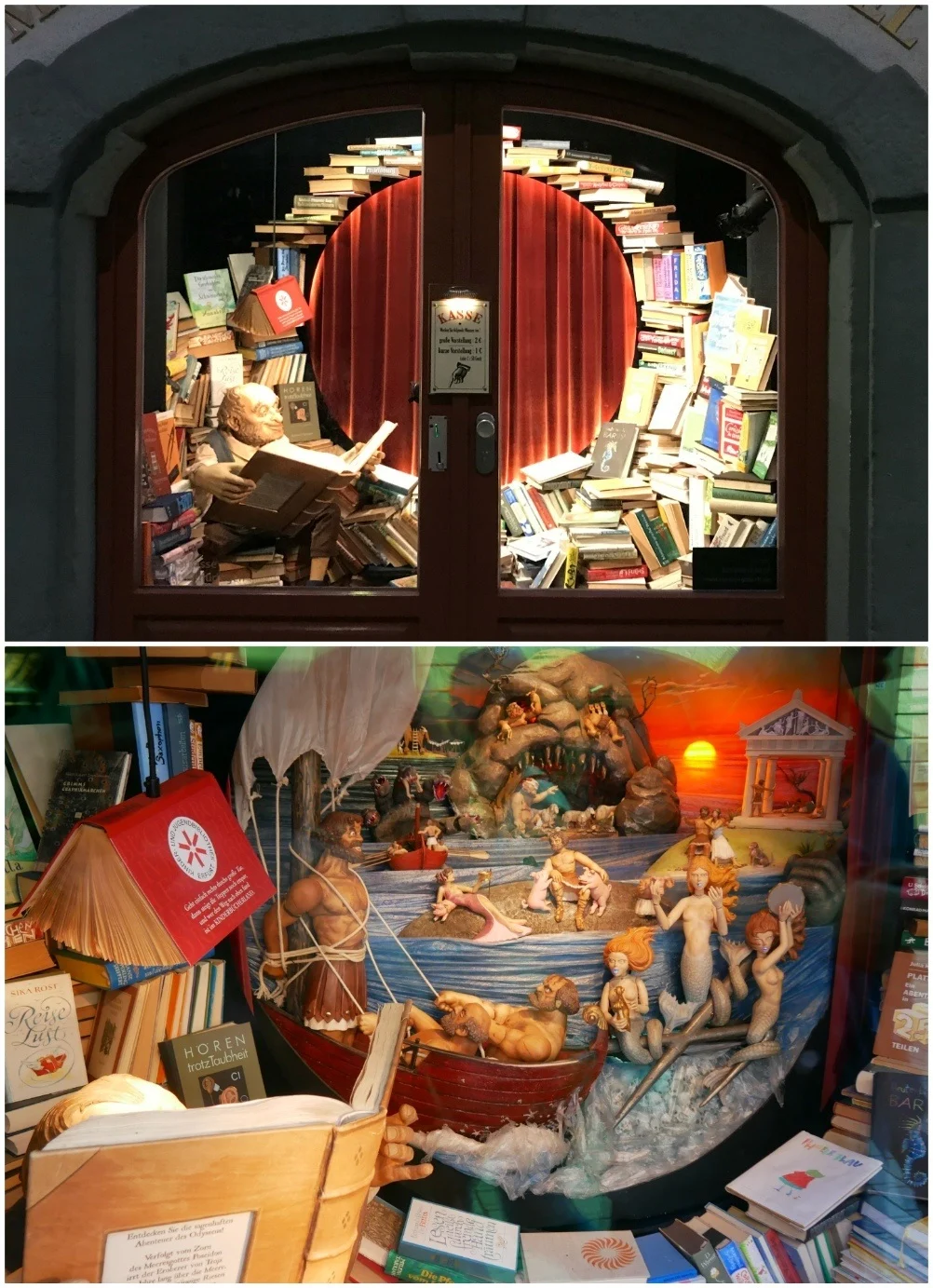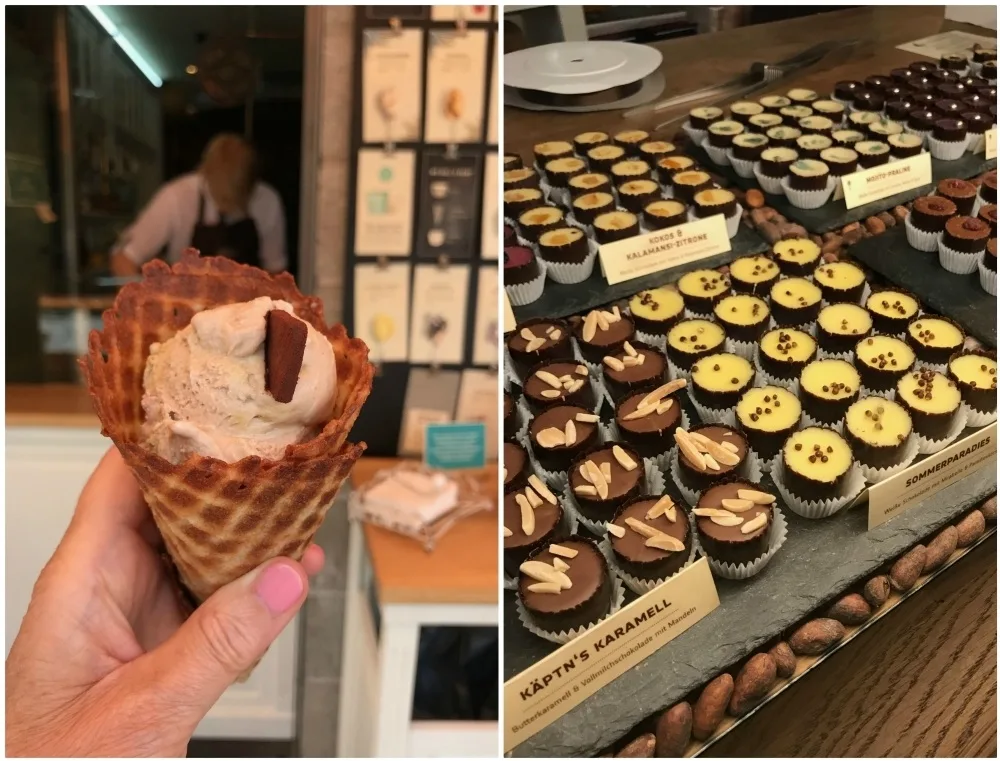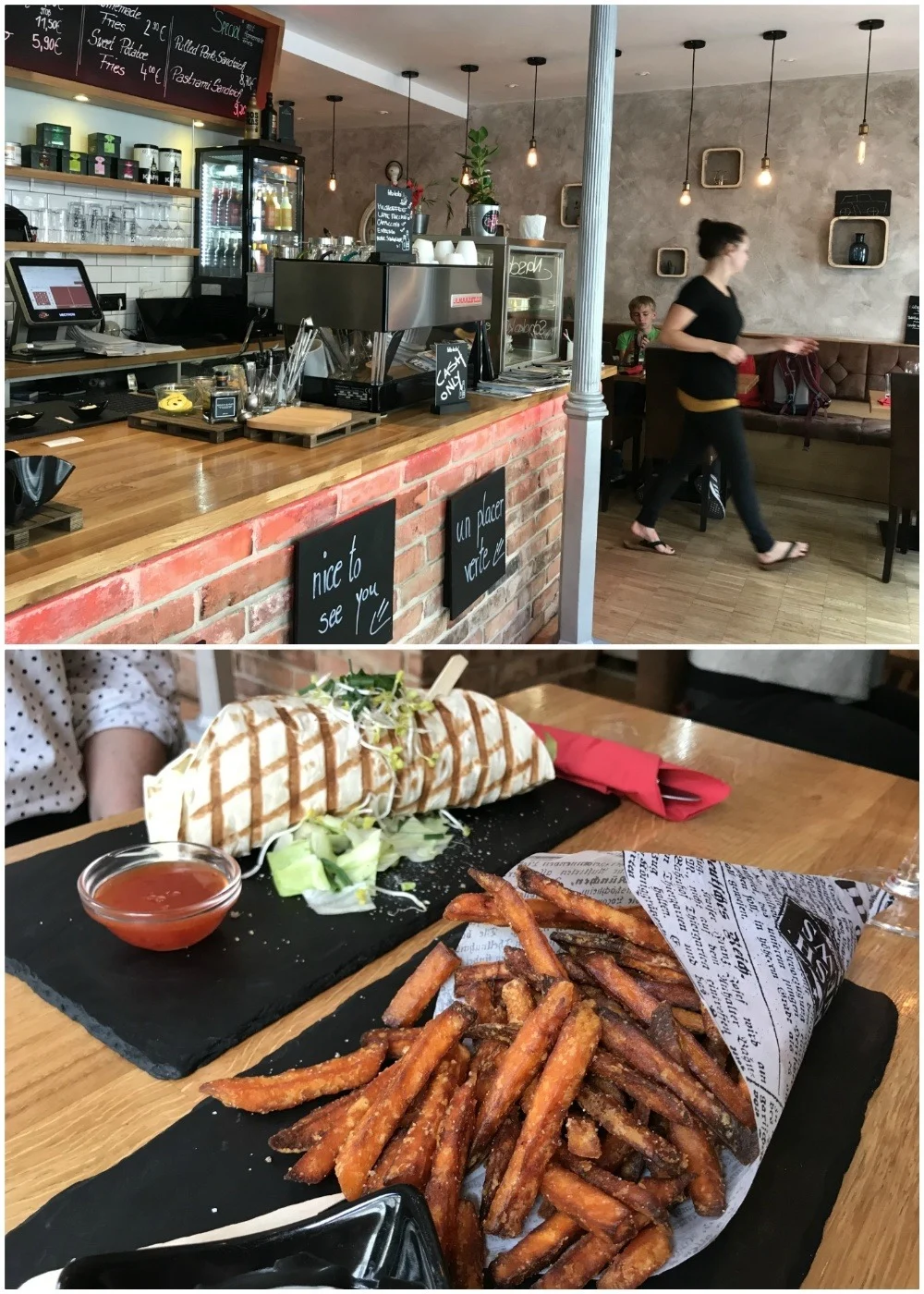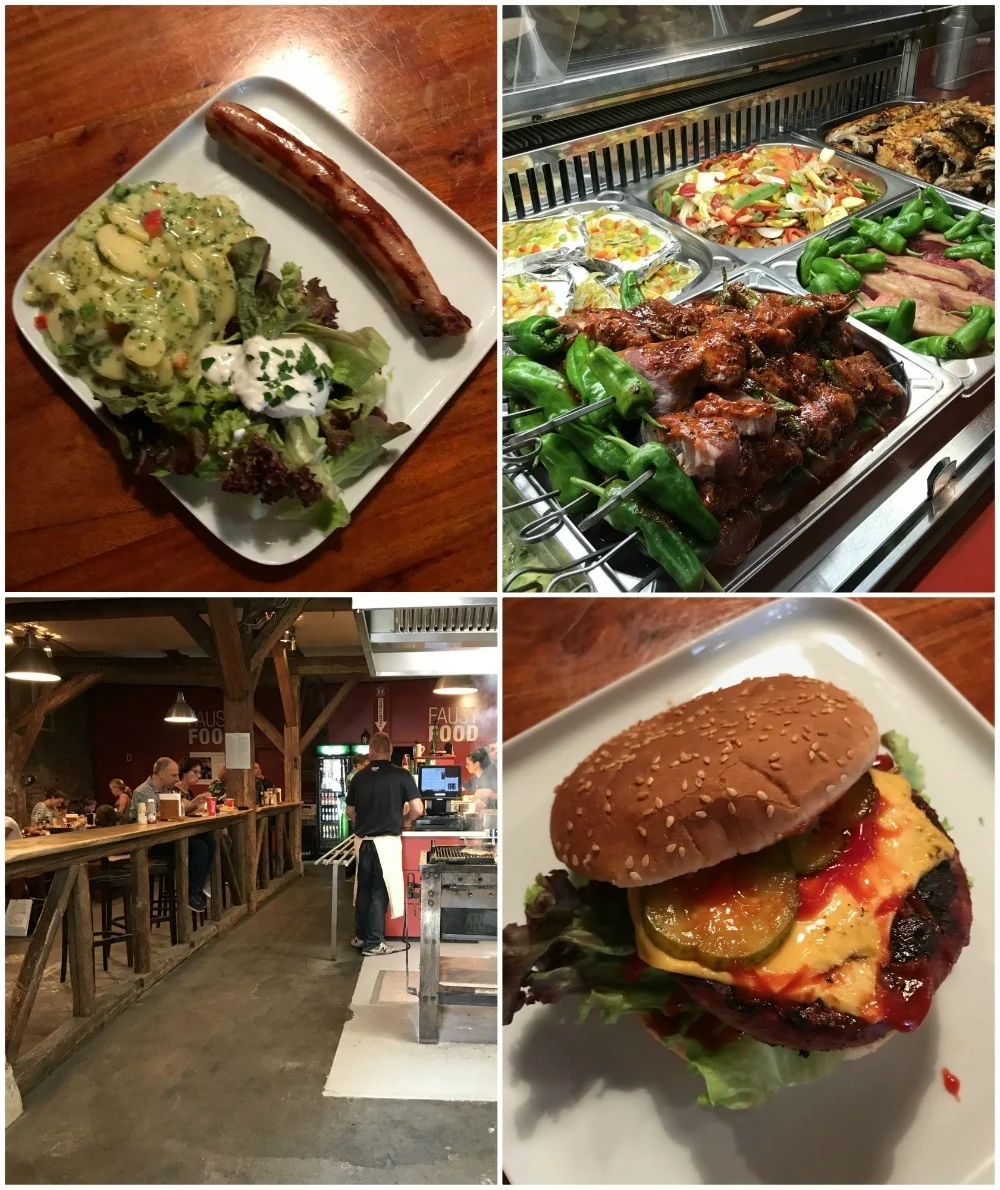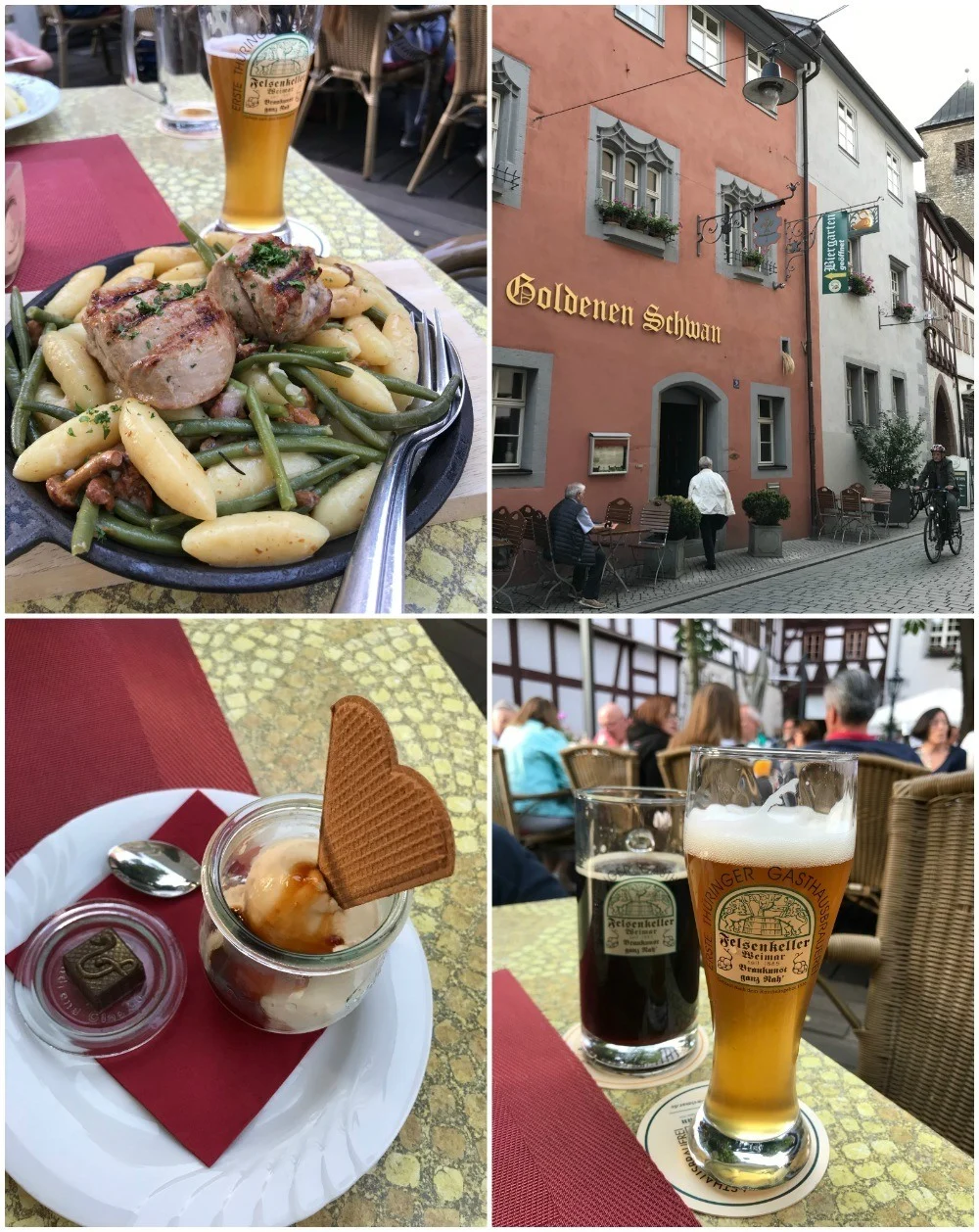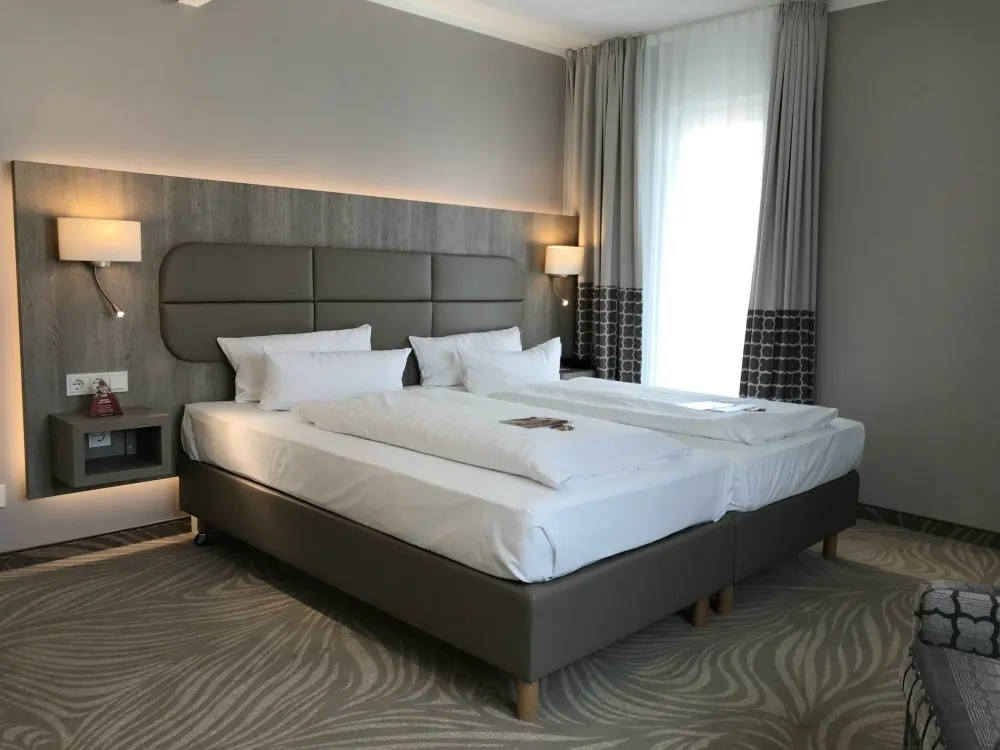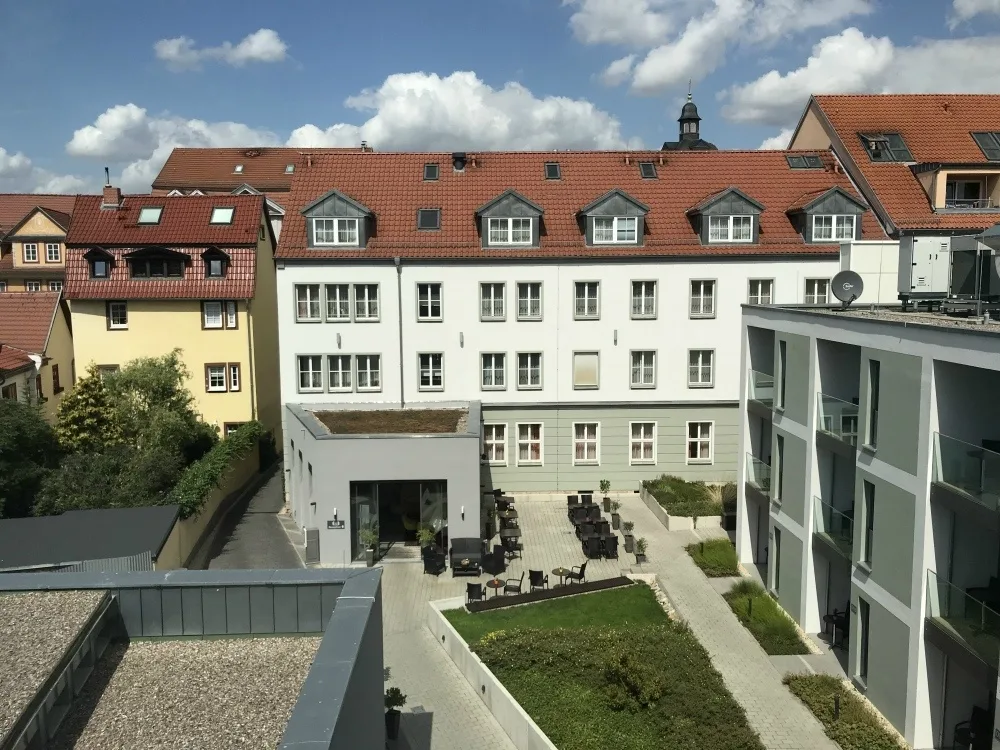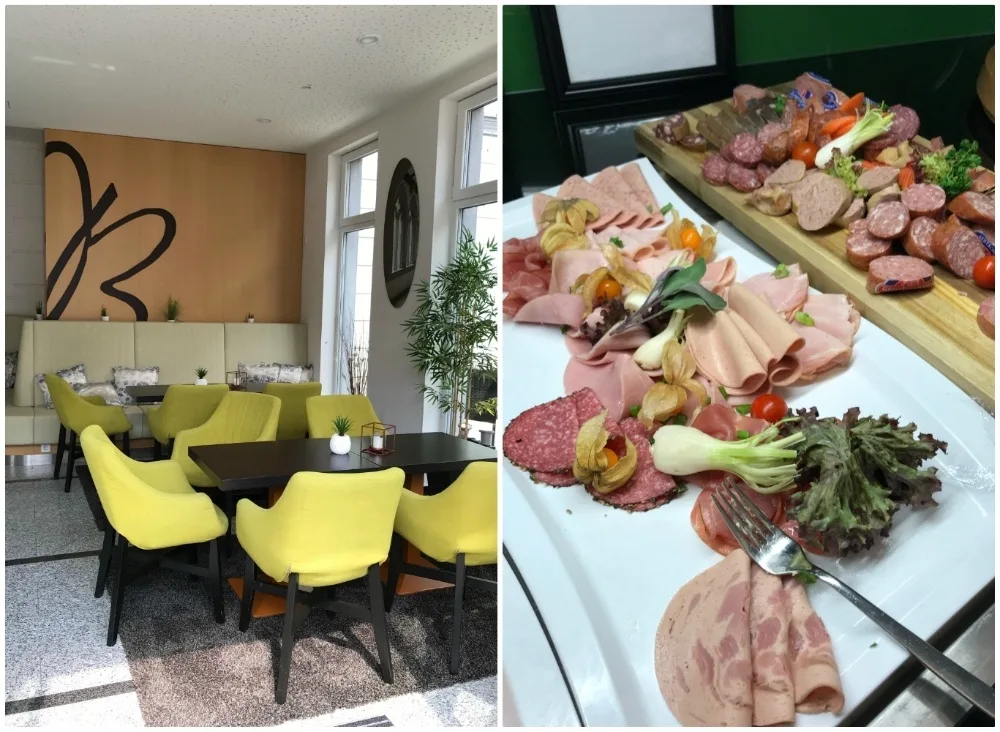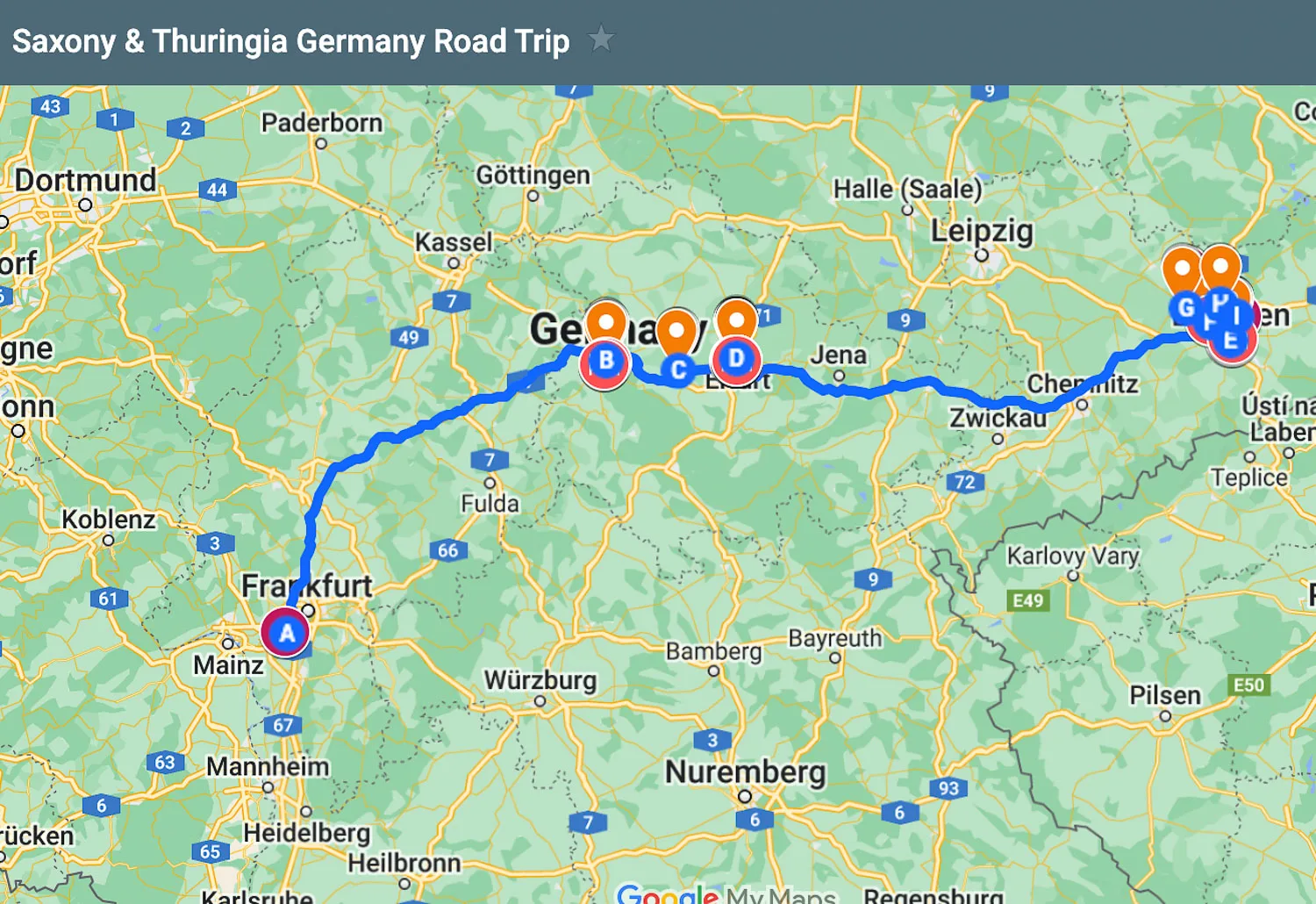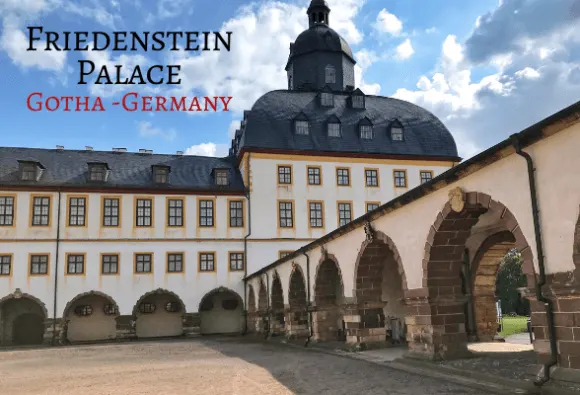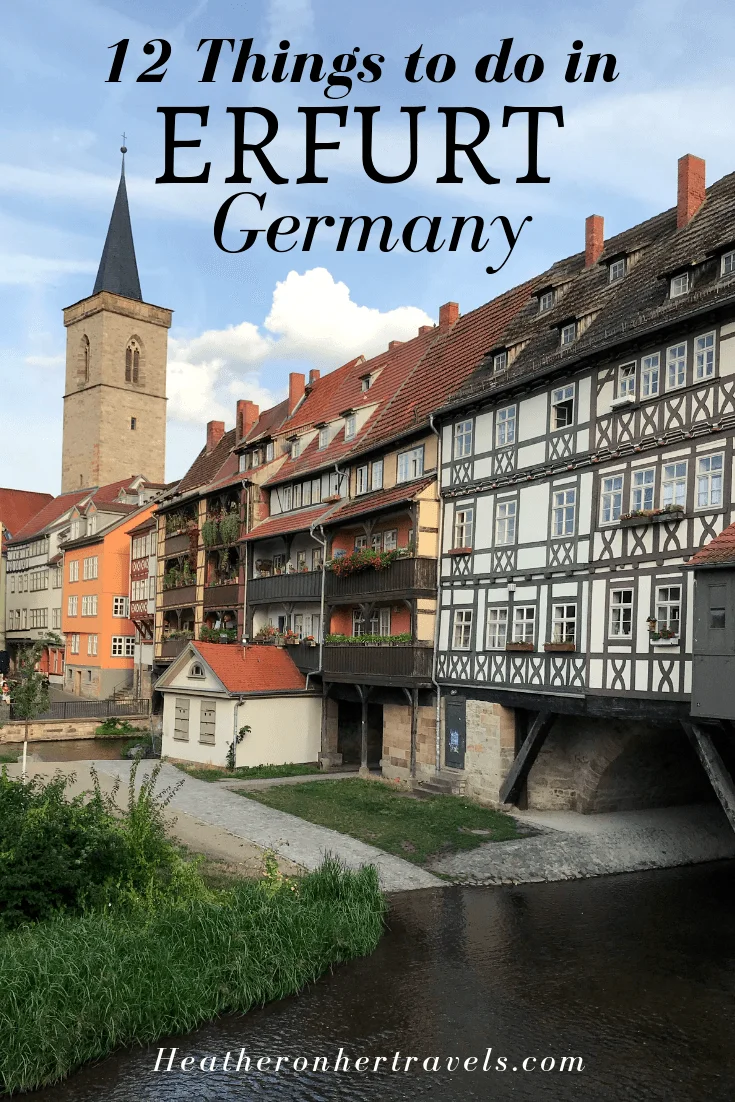Erfurt seemed to me the perfect example of a picturesque Medieval German town. It grew rich in the Middle Ages on the proceeds of Woad and stayed rich as a crossroads for trade on the old pilgrim route of the Via Regia.
There’s an easy going, small town feel here, as our guide Matthius told us “Erfurt is not a speedy city, people walk, they talk, Erfurt is a meeting point.” We visited as part of a 4 day road trip touring the Cultural Heart of Germany and discovered many fun and fascinating things to do in Erfurt.
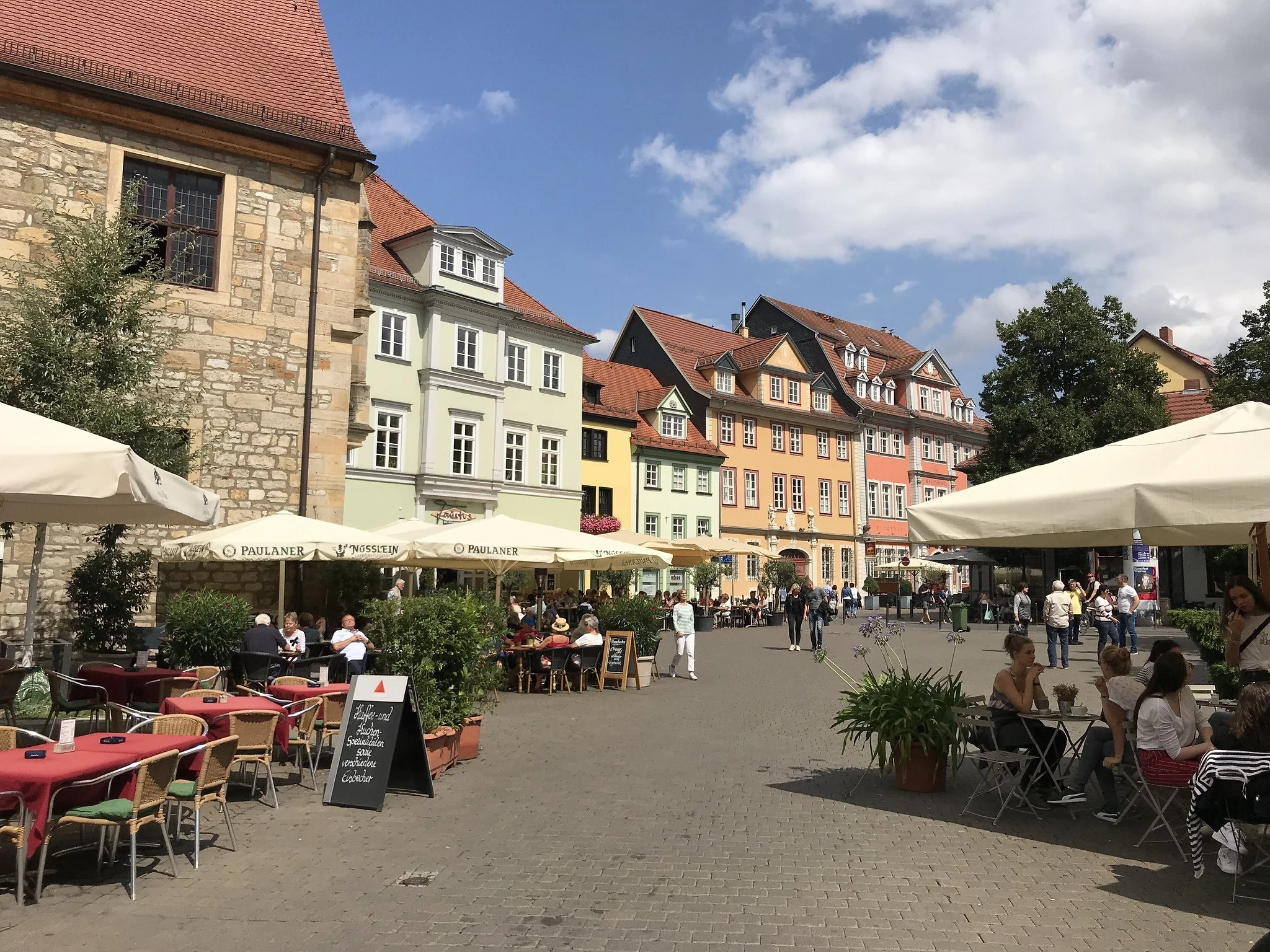
Erfurt is a university town set in the green heart of Germany and capital of the state of Thuringia. It was was part of former German Democratic Republic of East Germany between 1949 and 1990.
The shortage of cash during this period prevented modernisation, so Erfurt has a well preserved medieval centre. It was spared the worst of Allied bombing in WW2, and bags of culture, it is a charming place to spend a couple of days.
This article may contain affiliate links that provide commission on purchases you make at no extra cost to you. As an Amazon Associate I earn from qualifying purchases.
1. Walk over the Krämerbrücke or Merchants Bridge in Erfurt
One of the most popular things to see in Erfurt is the Krämerbrücke or Merchants Bridge. It is built across the River Gera, at a point where there’s a ford shallow enough to drive a herd of cattle through.
Markets were always an integral part of the public life of the town, a place for people to gather in the past. To ensure the town authorities could control and tax the commerce of the town, it was forbidden to sell goods inside private houses, so open markets were the hub for most commercial activity.
Markets were always an integral part of the public life of the town, a place for people to gather in the past. Town authorities wanted to control and tax the commerce of the town. Therefore it was forbidden to sell goods inside private houses. Open markets were the hub for most commercial activity.
You may also enjoy: A weekend in Coburg, Germany – castles and Royal connections
For luxury goods, however, it was not practical to sell in an open marketplace. The stone Krämerbrücke was built in the 14th century to replace previous wooden bridges that had burned down.
Soon houses were built on the bridge. This was where merchants for luxury products such as gold, silver, spices and fine cloth could own a house and run their business from the shop on the ground floor.
Half-timbered houses
Walking across the bridge, it appears like any other narrow street. The 32 half timbered buildings on either side contain the shops of artisans and artists, some of whom live in apartments above.
Tip: Look out for the symbols that mark each house. Before the postal service required houses to have numbers, you might be directed to the ‘House of the star’, or whatever symbol was above the door.
The bridge is now managed and maintained by a foundation. You can visit their house which was built in 1578, to see an exhibition about the bridge and look around the interior. It’s Haus Der Stiftungen (House of the Foundation), the one with the black and white timbers and glass bullseye windows.
Tip: Be sure to visit the basement built into the stone pillar of the bridge, where you can look out of the small window to see the river flowing beneath. Climb up to the wooden panelled room on the first floor where you can get some nice photos from the window.
There are many pretty shops on the bridge selling authentic local crafts. This is a good place to visit some of the shops and chat to the artists about their work, or look for hand made souvenirs to take home.
Woad plant
One of the shops sells pigments and has some interesting displays about the woad that was a source of rare and expensive blue dye. The woad plant is fussy about where it grows. Sunshine and abundant water from the Thuringia forest made it easy to grow in the villages around Erfurt.
Balls of dried woad leaves were brought into the town to be processed by fermenting with human urine. There was a good reason people joked that the merchants were “stinking rich”!
The blue dye was a luxury product that was exported all over Europe. It was a major source of wealth until the 17th century, when imports of cheaper indigo dye from Asia brought about its decline.
You may also enjoy: 15 fun things to do in Dresden – in just one day!
Other interesting shops that we enjoyed were the house of the puppet-maker Martin Gobsch. Gobsch creates wooden marionettes and has a puppet tableaux in his window which you can see if you put a euro or two in the slot.
We also stopped at the House of the Golden Helmet, now the Goldhelm Schokoladen where we purchased some of their artisan chocolates to bring home. They also sell ice cream at the popular shop next door which always seemed to have a long queue.
If you are visiting Erfurt in June, look out for the Krämerbrückenfest. This medieval themed festival that takes place on and around the bridge with food stands and entertainment.
Read more about Historic Germany in the Spring
2. Climb the Angerkirche tower for views over Erfurt
At one end of the Krämerbrücke is another landmark of the town. The Agidienkirche or church tower, is all that remains of an earlier medieval church. It’s now a Methodist church and you can climb the tower for views over the town from 11am to 5pm.
You may also enjoy: Romantic things to do in Heidelberg Germany
It was a not too arduous climb on wooden and stone staircase with landings to pass others coming up or down. On the way you can see the bells and at the top of the square tower there’s a viewing platform. You’ll get stunning views over the red tiled rooftops, river and Merchant’s bridge.
3. Visit St Augustine’s Monastery where Luther became a monk
St Augustine’s Monastery where Martin Luther lived as a monk and studied theology from 1505 until 1511. Luther had spent the previous 4 years studying law at Erfurt University.
After a dramatic religious conversion during a thunderstorm, he joined the St Augustine’s monastery. He used it as his base for teaching and study for 6 years until he left to teach at Wittenberg University.
You may also enjoy: Schloss Friedenstein in Gotha – The Victoria and Albert connection in Thuringia, Germany
After the reformation, the church was used by a Lutheran congregation. Now it’s a Protestant conference and study centre where you can stay in simple accommodation.
Many of the buildings were destroyed during bombings in WW2. The award winning modern glass extension has been built incorporating the remains of older stonework. You can walk freely through the grounds and visit the church with a beautiful original stained glass window.
4. Celebrate 100 years of Bauhaus in Erfurt
There have been lots of celebrations and special events during 2019 to mark the 100 years of the Bauhaus art and design school. The first Bauhaus school was founded in 1919 in Weimar, around 25 km from Erfurt. It moved subsequently to Dessau and Berlin, and was influential in its interdisciplinary approach and simplified modernist architecture.
You may also enjoy: 3 fabulous day trips from Dresden for culture lovers – Saxony, Germany
In the street that borders the St Augustine’s Monastery there’s a great example of a Bauhaus building. The former AOK health insurance office and hospital at 38 Augustinestrasse is typical of Bauhaus architecture.
Its horizontal lines and regular geometric windows and was designed by architect Theo Kellner who studied with the Bauhaus. The only ornamentation of the building is the sculpture carved into the stone around the door. This, by sculptor Hans Walther, reflects the themes of the building’s use as a health centre.
Another well known artist from the Bauhaus movement who was born in Erfurt is Margaretha Reichardt. Reichardt studied at the Bauhaus in Dessau and set up a weaving workshop in the 1930s in Erfurt. Her house and workshop showing some of her handlooms can be visited by appointment or as part of a guided tour.
Bauhaus themed products
As part of the Bauhaus 100 celebrations you can find special products around Erfurt that have been created for the centenary. We saw special edition of 3 gins at the Erfurt Distillery or the special pottery in the shop window on the Krämerbrücke.
Look out for the square, triangle and circle that have become the symbols of Bauhaus design. This after the artist and teacher Kandinsky conducted experiments in the association of shape and colour.
5. Admire the old buildings around Fishmarket square
I’ve mentioned that markets were the heart of public life in the Middle Ages. Your walk around Erfurt is bound to bring you to the Fischmarkt or Fish market.
In this open square there was formerly an open air market selling salt herring and cod as well as fresh fish from the river. Fish was a staple of the working classes in the days when meat was expensive and it was difficult to keep food fresh.
You may also enjoy: Rosenau Castle in Coburg Germany: Victoria and Albert’s romantic retreat
Around this square are some beautiful historic houses although it’s not always obvious which are the oldest and which are built more recently. Take for instance the beautiful pink Merchant’s house Zum Breiten Herd (House of the wide hearth). It was built in 1584 and now houses an Italian restaurant.
If you look to its right you will spot that the decorations on the front of the less colourful Guildhall are identical. But, this was built 300 years later in the 1880s to fill a gap in the buildings.
On the other side of the square is the imposing neo-gothic town hall that was completed in 1874 but fits in well with the older merchant houses. You’ll often find street musicians playing in the square, so it’s a nice place to relax in one of the pavements cafes.
6. Visit the Old Jewish Synagogue and Mikveh baths
To discover something of the Jewish community that lived in Erfurt in the Middle Ages, we visited the Old Synagogue. It’s tucked down a small side street.
In the Middle Ages, the town was the scene of more than one tragic massacre. During the Pogrom of 1345 the Jews were made scapegoats for the Black Death sweeping Europe. The whole Erfurt community of 900 Jews was killed in the town.
You may also enjoy: A guide to Wartburg Castle and Eisenach – on the Martin Luther Trail in Germany
This medieval building dates back to the 11th century and has been identified as the old Jewish synagogue. View the Torah shrine that faces east towards Jerusalem and the cornice all around the room.
Oil lamps are placed on the cornice as the congregation read their prayers. After the Pogrom the house was put to many different uses, before being restored as a museum opening in 2009.
The Old Synagogue also houses a collection of silver coins, jewellery and fine gold and silverware. These items were buried around this time by Jews to avoid their precious goods being looted.
The Erfurt Treasure was discovered in 1998 by archaeologists, buried under a nearby cellar. It includes the famous medieval Jewish wedding ring, decorated with clasped hands, a Gothic tower and engraved with the words Mazal Tov or Good Luck. More information to visit here, the Old Synagogue is open daily except Monday.
Visiting the Mikveh
We also visited the Mikveh or Jewish ritual bath which was built in the 13th century and used for ritual purification. At that time the town as much more densely populated with buildings covering the whole bank of the river that is now green space.
The domed brick building houses the bath and was filled by groundwater or water from the river running outside. Since the river would have been at a higher level than it is today, it allowed complete immersion in the bath.
A Mikveh is only available to visit with a registered guide as we did or in one of the weekly public tours. However, you can look down into the Mikveh from a viewing window in the park above close to the Merchant’s Bridge.
7. Try the Thuringia sausage
If all this sightseeing has made you hungry, you might want to take a break for lunch and try the famous Thuringia Sausage. We ordered ours at Faust Food in the old Jewish Quarter. The Germans love their sausages and lots of towns or regions have a ‘special’ sausage. Each is distinct in the herbs and spices that are mixed with the meat and the way it is cooked.
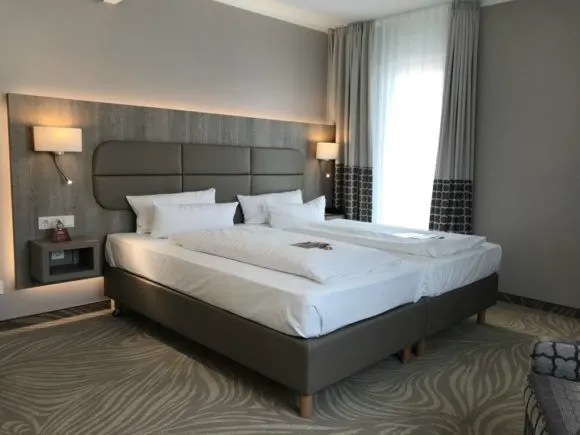
Stay at the Hotel Am Kaisersaal in Erfurt
Search for other hotels in Erfurt
The Thuringia sausage is made of minced pork or beef. Over half of the ingredients must come from the state of Thuringia, so it’s a great way to support local producers.
There’s a specific blend of seasonings such as caraway, marjoram and garlic. The sausages must be freshly made and sold by licenced butchers on the same day they are produced.
Thuringia sausage is cooked over charcoal and served in a long white bread roll. The ends of the sausage hang out of the roll, so that you can easily take a bite.
A favourite condiment is plenty of mustard, especially the local variety of Born mustard (you can visit their shop in Erfurt). While you may squirt tomato ketchup on your sausage, you’ll mark yourself out as a ‘westerner’ rather than a local East German.
8. Visit the Erfurt Cathedral
St Mary’s cathedral is another of the major landmarks of Erfurt, sitting on the high ground overlooking the town. It’s next to the smaller but still impressive St Severus church.
The church is believed to be older than the cathedral and belonged to the order of St Augustine in the 12th century. We visited the cathedral, which was founded by St Boniface who built a church on this spot in 742 as part of his plan to establish a bishop’s seat in Erfurt.
When you observe the cathedral from the square below, it’s easy to see the smaller section based on the original church. It’s now dominated by the Gothic choir, extended out on supportive arches. Inside there’s a large medieval mural of St Christopher, patron saint of travellers, which was the first thing that pilgrims would see on entering the cathedral.
A highlight was the bronze Wolfram candelabra that looks incredibly modern even though it dates to 1150. Also view the wooden choir stalls with intricate wooden carvings of Adam and Eve intertwined with the natural world.
While we were there in August, the Cathedral Steps festival was taking place. The steps leading up to the cathedral were transformed into the stage set for an operatic production.
Each year a different a different open air production is performed here. In 2019 it was The Name of the Rose, while 2020 will see Verdi’s Nabucco performed. More information about the Cathedral Steps Festival.
9. Explore the tunnels under the Petersberg Citadel in Erfurt
The enormous star shaped Petersberg Citadel was built in 17th century on the edge of the walled town of Erfurt, although there had been a fortification on this piece of high ground for many centuries before.
This design of fortress was difficult to penetrate with artillery. One of the ways that it could be overcome was for enemies to tunnel under the walls and place explosives to blow it up from below.
To counteract this, a network of “listening tunnels” were built which you can visit in a guided tour. Here the soldiers would have to sit on duty for hours, to listen out for any signs of tunnels being dug to undermine them.
It was quite spooky and dark to walk through the tunnels, gradually rising up hill until we emerged in the fortress museum. It’s free to walk around the grounds of the citadel. At the time of our visit there was lots of work going on to prepare for the Buga garden festival that will be taking place in 2021.
10. Spirit tasting at the Erfurt Distillery
It’s worth combining your visit to the Petersberg Citadel with a tasting at the Destille Erfurt distillery. The distilery is open on Friday, Saturday and Sunday or by appointment for groups. This gold medal winning distillery produces all kinds of spirits such as gin, whisky, brandy and rum as well as the more traditional fruit flavoured spirits.
The brick domed bar of the distillery is the former ammunition store and laboratory of the Petersberg Citadel. It was built in the 1830s just outside the fortress walls in case the gunpowder experiments went wrong and it all blew up.
There’s a copper kettle where the macerated ingredients are distilled before being matured in oak barrels for up to 20 years. If you’d like a tasting experience they also offer platters of cheese and charcuterie with bread on Fridays and Saturdays to accompany the spirits of your choice.
I hadn’t quite realised but almost any flavour can be macerated and distilled into a spirit. Among the more unusual flavoured spirits made here are those flavoured with coffee, chocolate, pine cones and even mustard! As I mentioned before, this is where we saw the special edition trio of gins that were created for the Bauhaus 100 celebrations.
11. Sit on a mushroom seat in Erfurt and watch the world go by
There are a couple more fun things that I enjoyed during our visit to Erfurt, which you might easily miss unless you have them pointed out to you. One is the stone “mushroom” seats that you often see on either side of the doorways of older houses. Once you know what they are for, you’ll start to notice them everywhere.
These seats are where the owner or servants of the house might sit and watch the world go by, catching up on the local gossip. Perhaps the would invite friends to sit on the other seat and sip a cup of coffee while they shared their news.
12. Watch the puppet show in a shop window
We also enjoyed the puppet windows by the puppet maker Martin Gobsch who I already mentioned has a shop on the Krämerbrücke. There’s another shop that you’ll find as you walk along the road that leads from the bridge to the cathedral. Putting a Euro in the slot we enjoyed the puppet show of Odysseus tied to the mast as his boat rows past the sirens and other scenes from his story in Homer’s Iliad.
Where to eat in Erfurt
Ice cream and chocolate at Goldhelm
I mentioned that Goldhelm Schokoladen have a shop on the Krämerbrücke. But it’s worth knowing that they have three premises in Erfurt where you can try their delicious ice cream, chocolate and cakes.
On the bridge there’s the original chocolate shop in the house of the Golden Helmet (Goldhelm). Next door is their ice cream shop where there always seemed to be a long queue.
But you may not realise that just a short distance from the bridge they have a cafe (Kreuzgasse 5), with lots more space where you can buy the same selection of ice creams. Although I didn’t sit down there the cakes looked very tempting and there’s lots of seating and grass by the water to eat your ice cream.
Eat in Erfurt
We tried this unassuming little cafe called Eat Erfurt in a side street (Pilse 7) for lunch. The selection is quite small and the decor is trendy rather than traditional, the food was excellent too. I tried a vegetarian taco (more of a wrap than a Mexican style taco) with a serving of sweet potato fries. It was all very tasty and well priced.
Restaurants in Erfurt – Faust Food
If you want to get stuck in to burgers and all things meaty or perhaps try the Thuringia Sausage, head for Faust Food (Waagergasse 1). Here they have a charcoal stove to grill your chosen meat, burgers or steaks.
It’s a relaxed and informal experience in an old medieval barn with brick walls and huge timber beams. You order at the counter and sit at solid wooden tables. I tried the cheeseburger while Guy had a Thuringia Sausage with potato salad and green salad leaves with a sour cream dressing.
Restaurants in Erfurt – Zum Goldenen Schwan
Staying with the Thuringia specialties, beer lovers will thrive at Zum Goldenen Schwan. This traditional gasthouse serves pub style local food with a beer garden courtyard at the back where we sat out.
I was very happy with my choice of tasty pork medallions Schupfnudelpfanne (small potato dumplings), chanterelles and green beans in a creamy sauce. Guy looked on enviously having chosen the “Housewife style” pickled herring with potato salad, gherkins and sour cream which he found just a bit too much of the pickled flavours.
I was intrigued by the trio of beer desert, with beer ice cream, dark beer syrup and a beer flavour chocolate truffle. Nice try although I found the bitter beer flavours quite overpowering. If you are a lover of dark beer this will be for you.
The Golden Swan also brews its own beer and I ordered the Weizenbier (Wheat beer) which is fruity and golden and my favourite when I’m in Germany. Guy went for the Schwarzbier (Black beer ) with malty, dark roasted flavours. Are you a light or dark beer drinker?
Stay at Hotel Am Kaisersaal in Erfurt
We really enjoyed our one night stay at Hotel Am Kaisersaal. This excellent modern hotel gives little away from its unassuming entrance on the street.
It’s one of a small group of Bachmann Hotels, and in addition to the 85 bedrooms they offer 2 bedroom apartments for a minimum 2 night stay. This would be ideal if you want a little longer to explore the area.
Behind the traditional looking front building, the Hotel Am Kaisersaal has further modern accommodation wings. It’s built around a pleasant grassy courtyard, with a convenient underground car park.
The atmosphere was calm and friendly, with the usual excellent breakfast spread you find in Germany. Our bedroom was contemporary and well designed with a pleasant outlook over the courtyard. The hotel was very well located just a few minutes walk from the Krämerbrücke.

Stay at the Hotel Am Kaisersaal in Erfurt
Search for other hotels in Erfurt
You may also enjoy
Tips for seeing the Oberammergau Passion Play for 2022
Where and what to eat in Munich – all the delicious food in Munich
Plan your trip to Erfurt in Thuringia, Germany
You’ll find more information to plan your trip on The Cultural Heart of Germany Website. Also the Visit Thuringia website and the Erfurt Tourism website.
The closest airport to Erfurt with a wide range of international flights is Frankfurt. There are smaller airports at Erfurt, Leipzig and Dresden.
We flew into Frankfurt then took the train to nearby Eisenach, where we picked up a hire car from Europcar close to the station. There is a train station a Erfurt and the German rail network is very efficient. This would be a good way to reach Erfurt from other airports or regions of Germany, as an alternative to a hire car, which we used.
Once you arrive in Erfurt, you can easily see all the main places on foot although there’s also a good public transport network of trams.
Visitor Information for your trip to Erfurt in Thuringia, Germany
If you are looking for a guidebook for your visit to Thuringia and Germany, we recommend the DK Eyewitness Travel Guide to Germany.
Guided Tours: If you need a guide for your visit, there are many excellent registered guides and these can be arranged in advance of your visit through Erfurt Tourism. Take a look at the options available on the Erfurt Tourism website.
There are also options for self guided tours or public tours to join. An iGuide is available to rent from the Tourism Office (Address: Benediktplatz 1). You can enquire at the Tourism office about other public tours taking place during your visit.
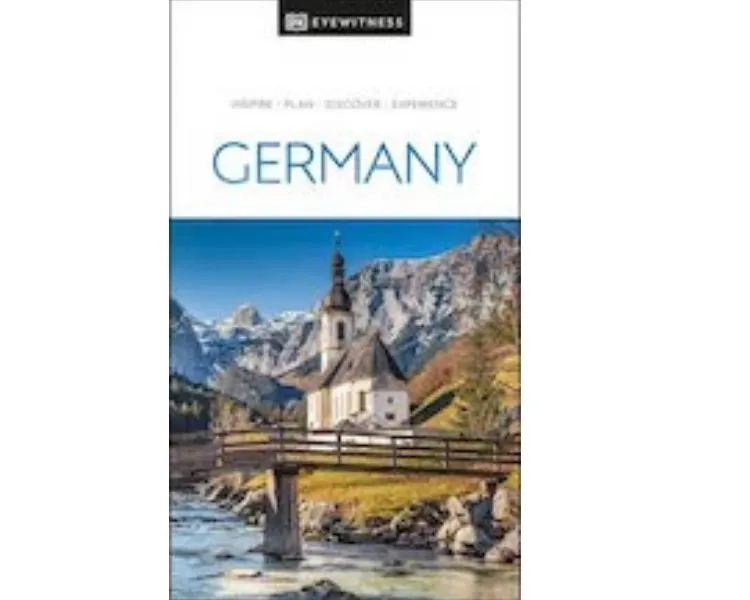
Need a guide book for Germany? We recommend the DK Eyewitness Germany Travel Guide
Erfurt Card: If you are visiting Erfurt for a few days it’s worth looking at the Erfurt Card. This gives free use of public transport, entry to museums and discounts on many tours and attractions. This can be purchased at the Tourism Office on arrival.
Where is Thuringia?
Erfurt is the regional capital of the German state of Thuringia, which is in the centre of the country and was formerly part of the East German GDR. Thuringia is bounded by the better known Bavaria to the south and Saxony to the east. The rolling rural countryside, green belt of Thuringia forest and pretty medieval towns, castles and palaces make this an ideal road trip destination.
You can see all the places we visited on the map below.
Read Next
Read about Schloss Friedenstein in Gotha – the Victoria and Albert connection in Thuringia, Germany
Pin it
This article was sponsored* by The Cultural Heart of Germany, Thuringia Tourism and Visit Saxony who provided the 4 day trip and experiences mentioned.
* More info on my policies page
This article is originally published at Heatheronhertravels.com

